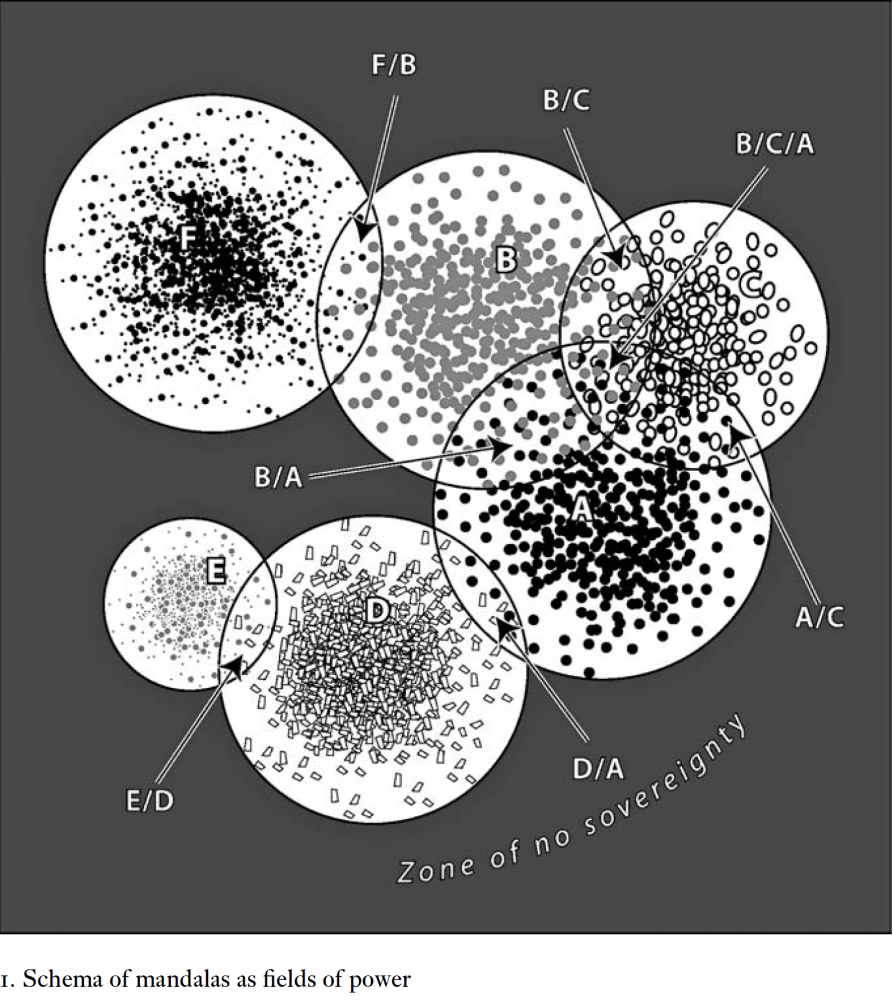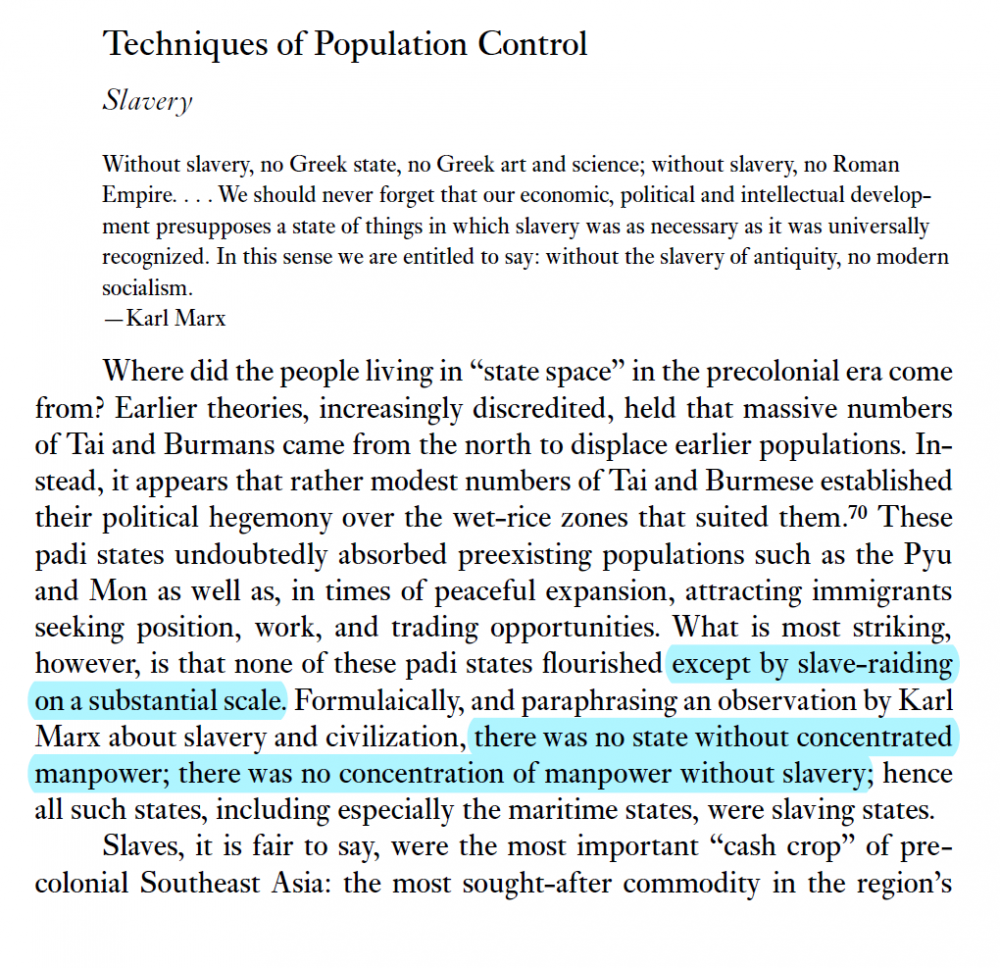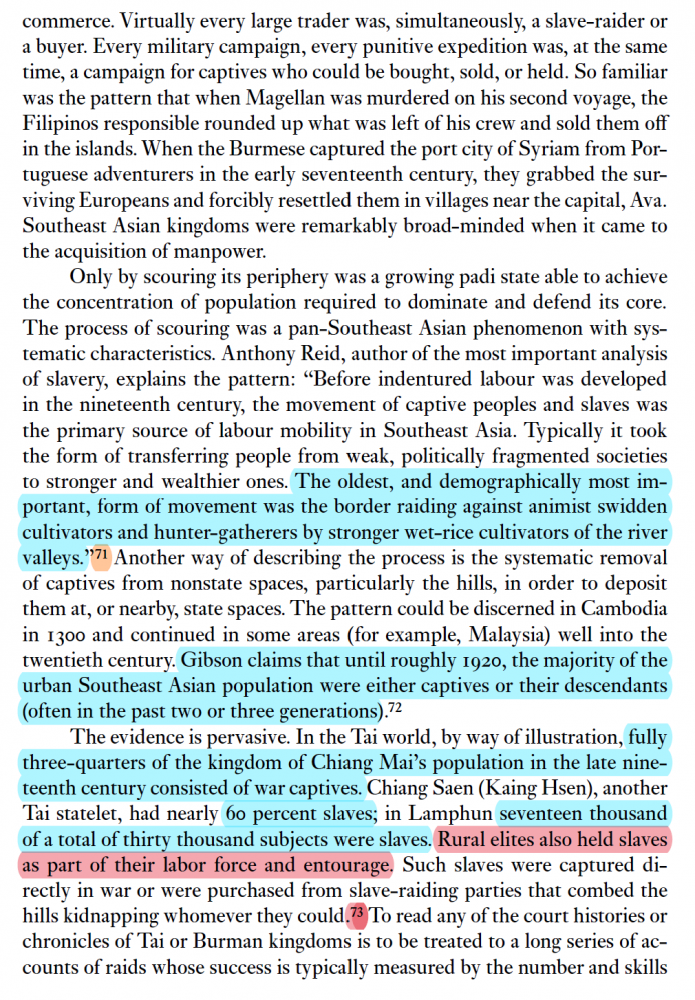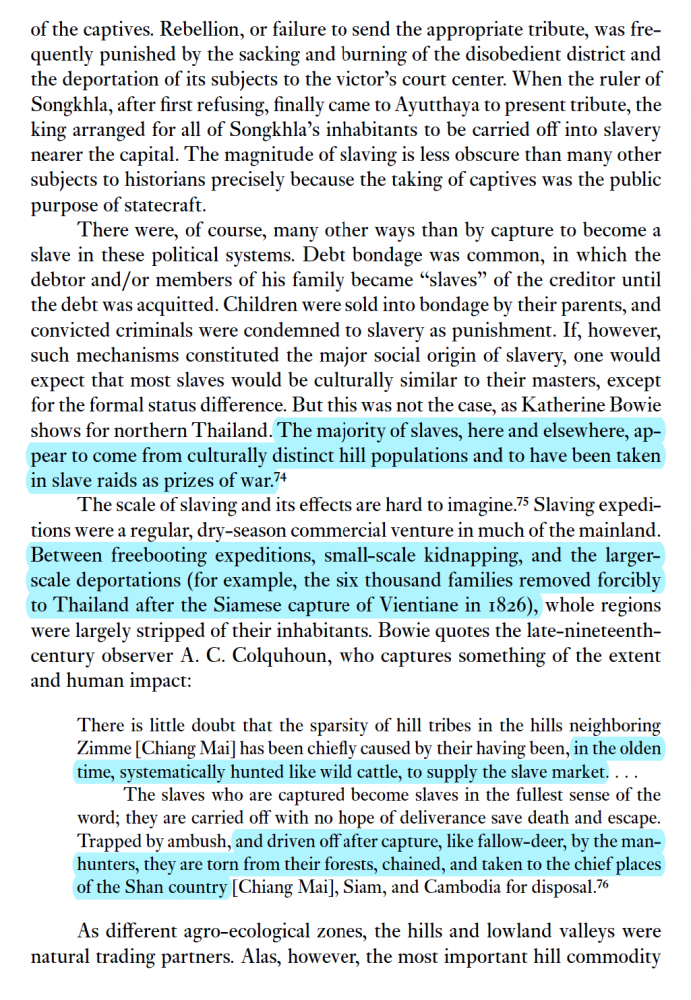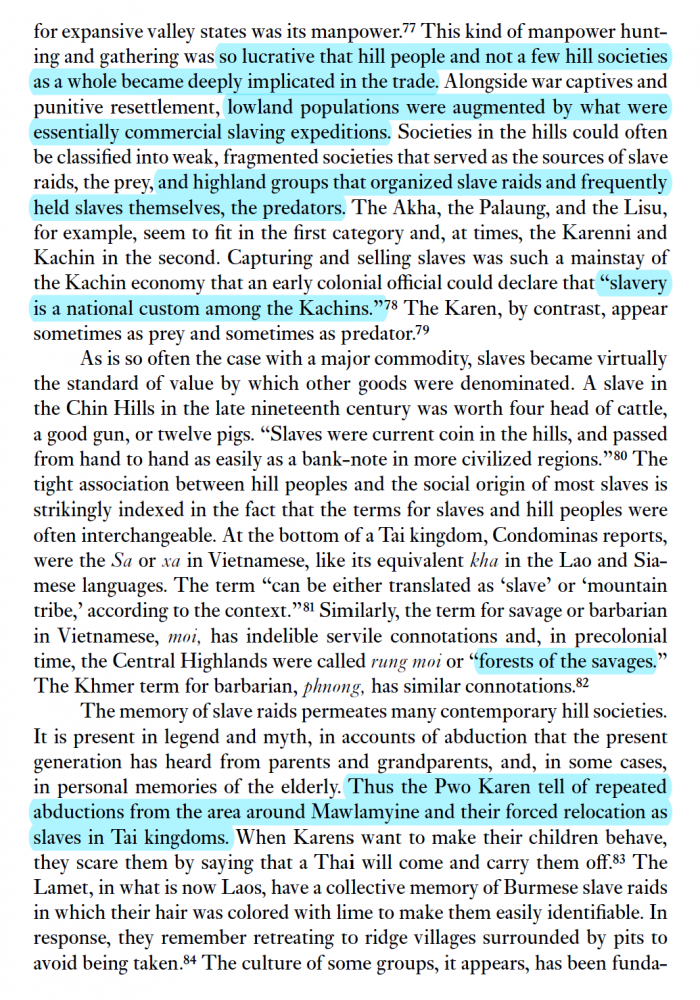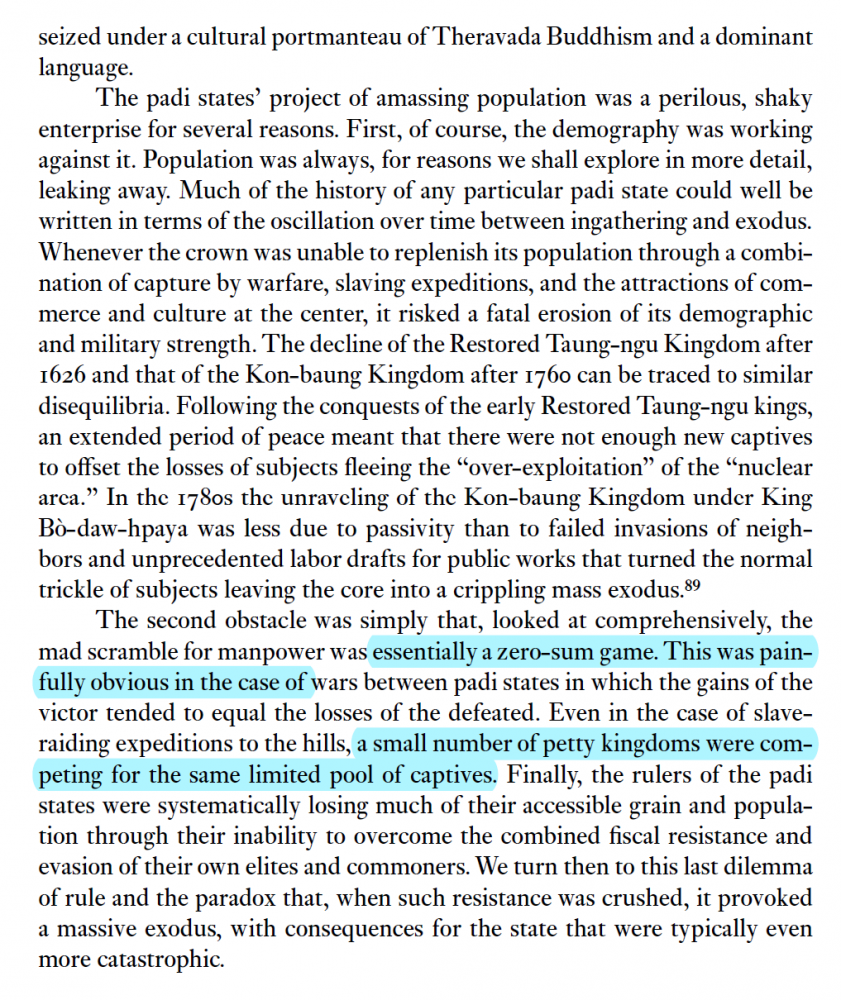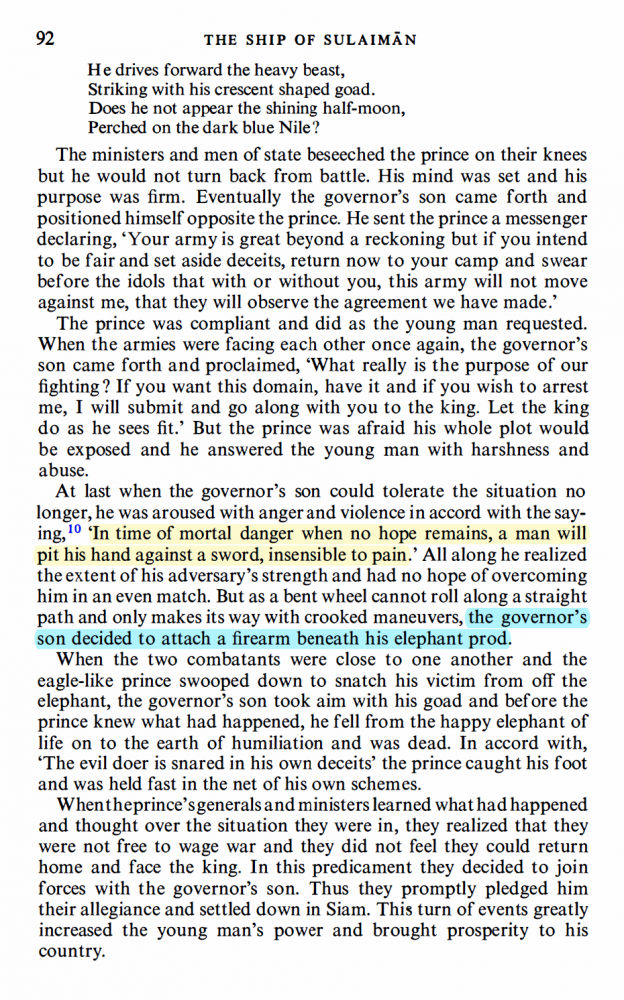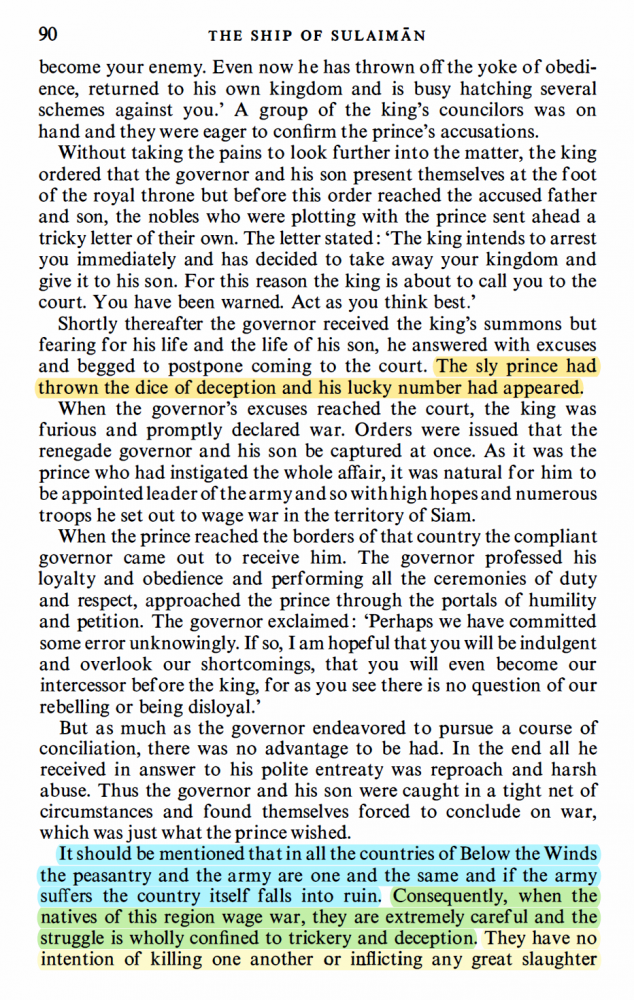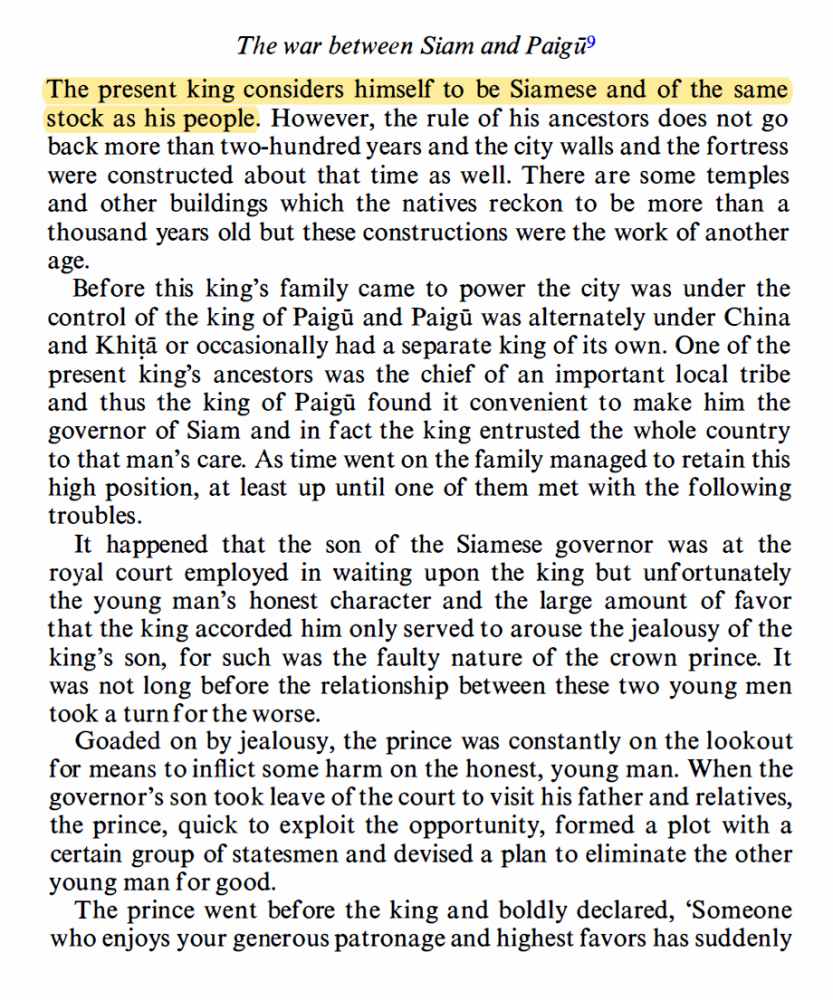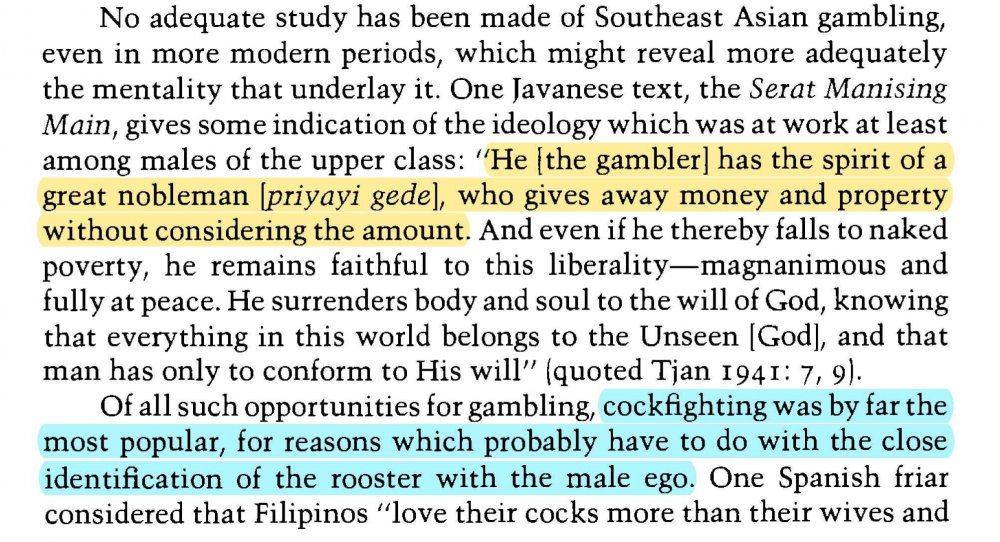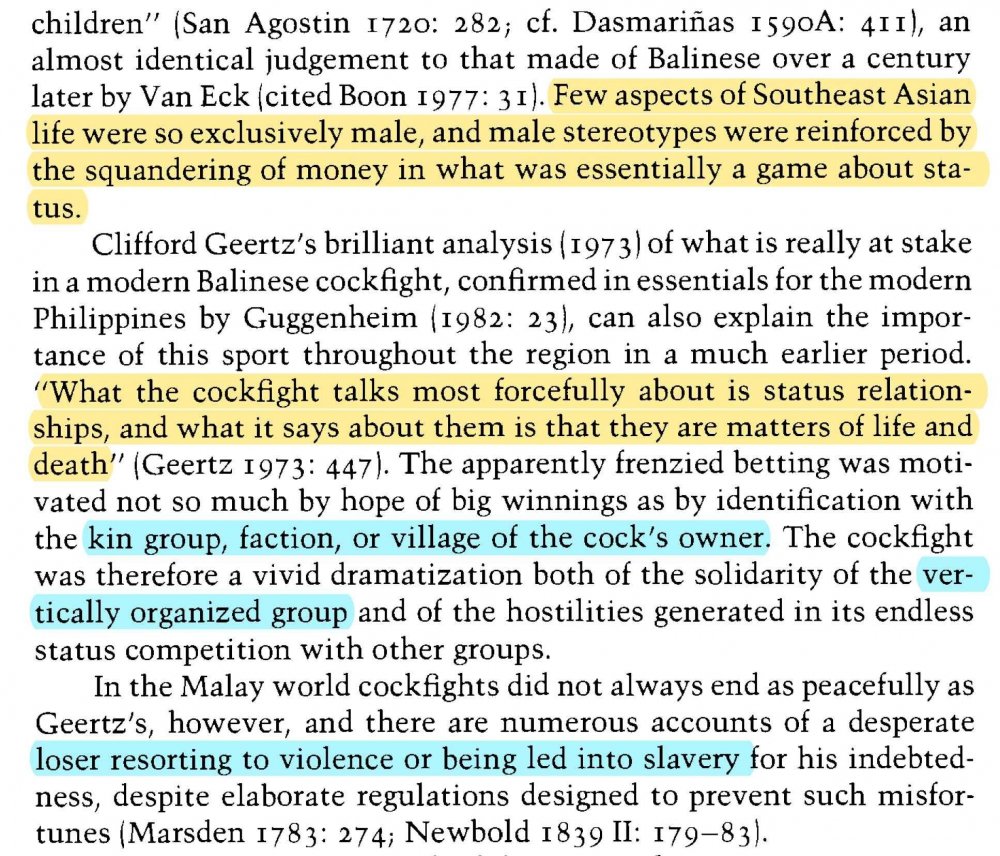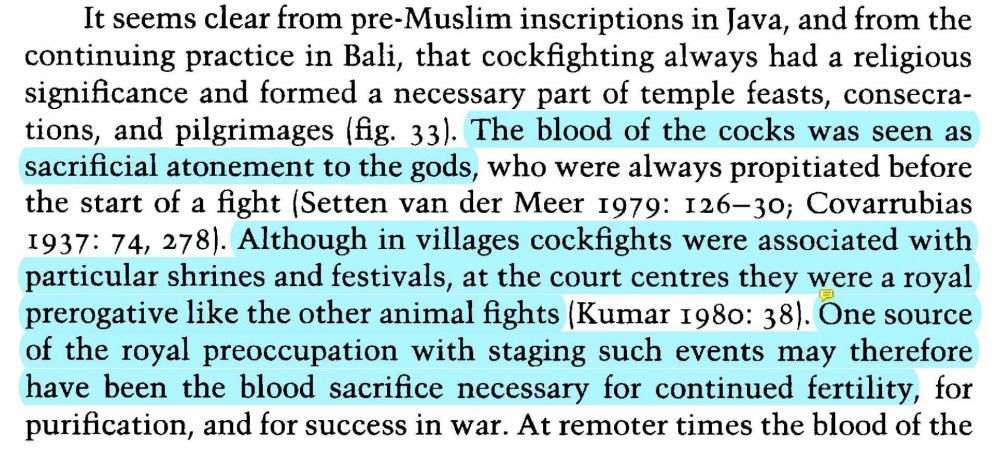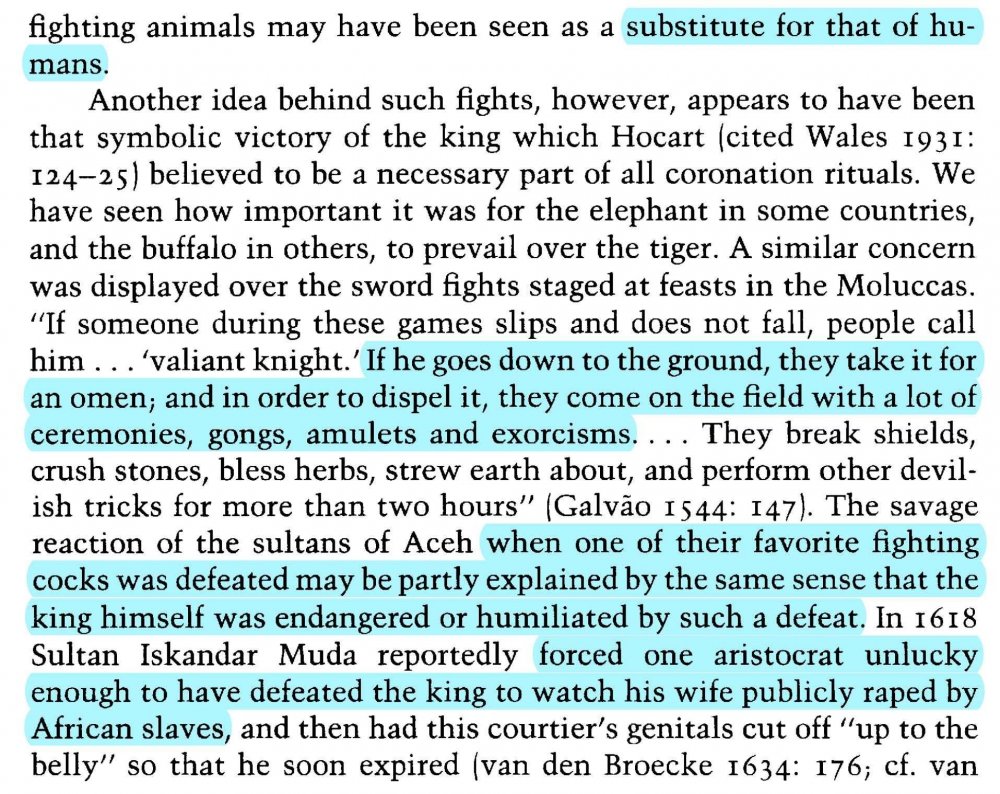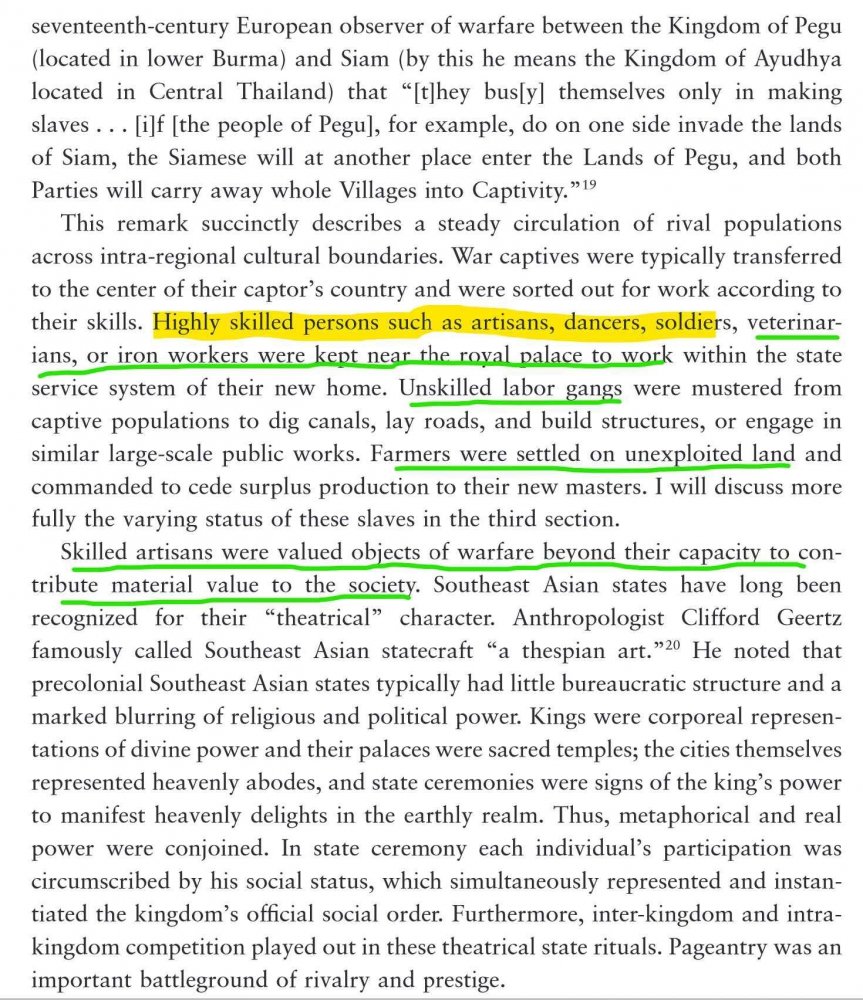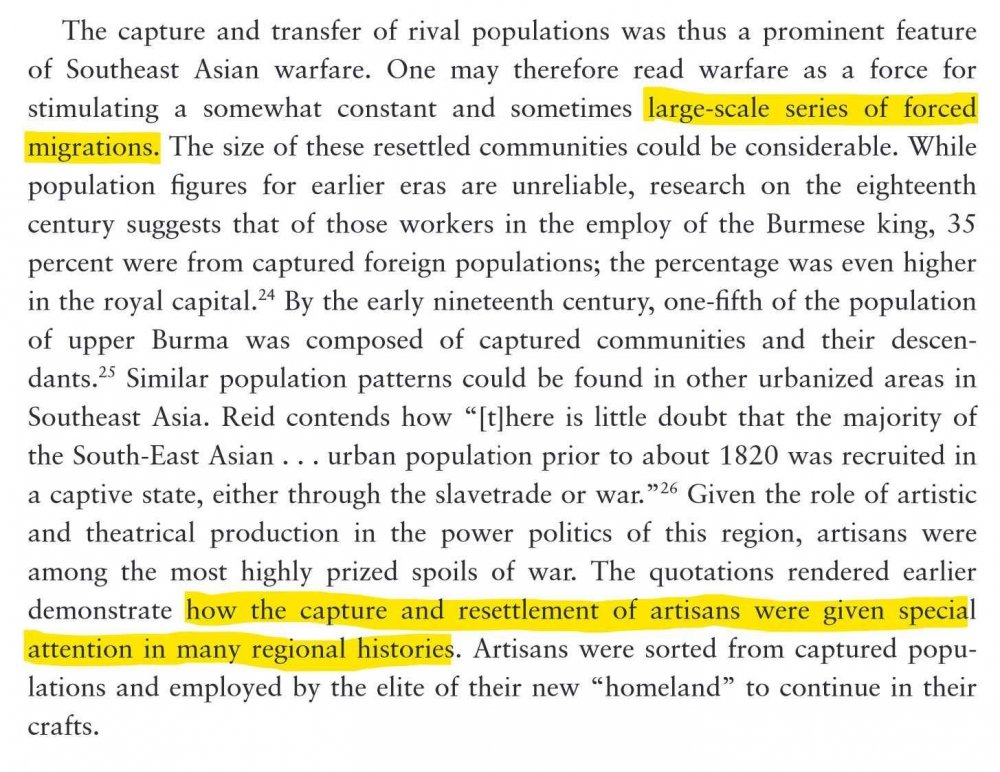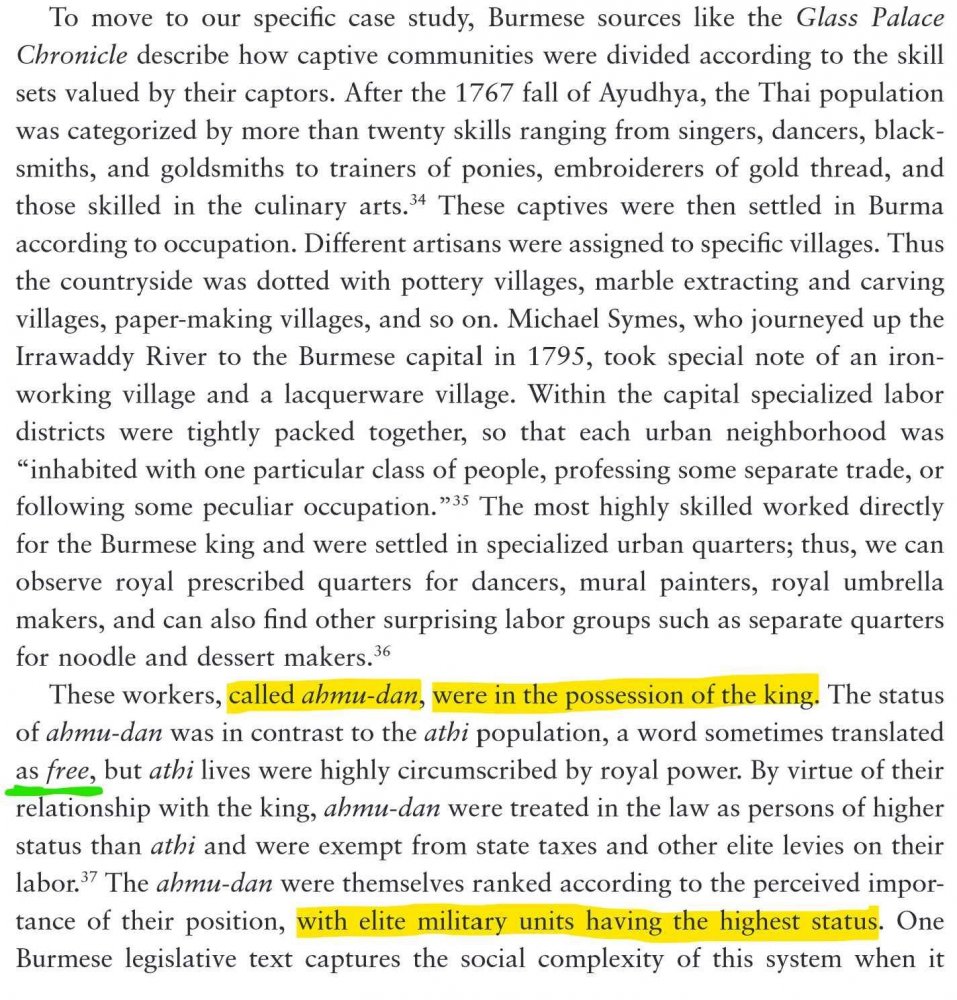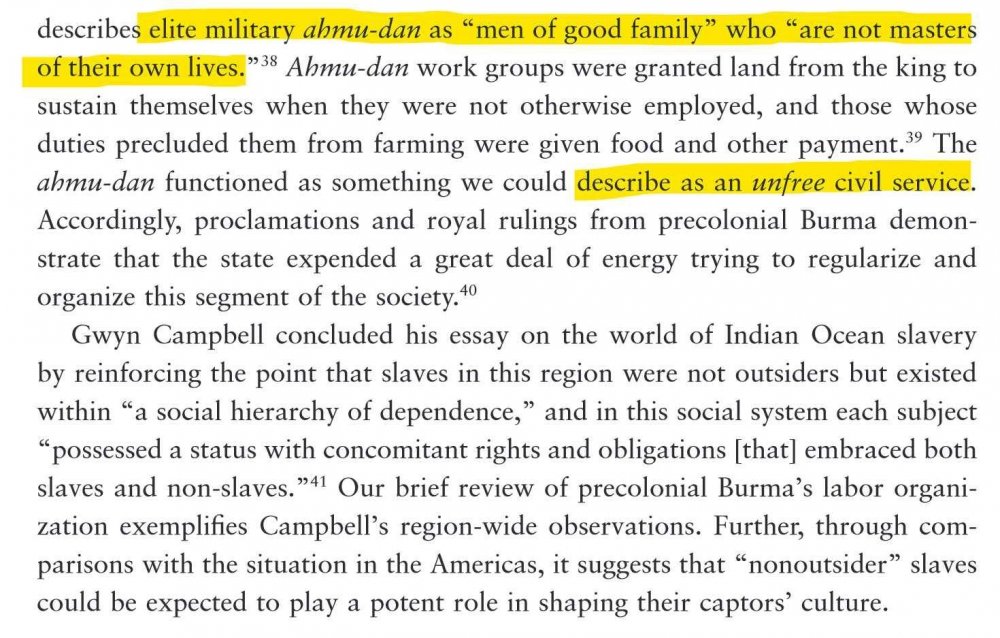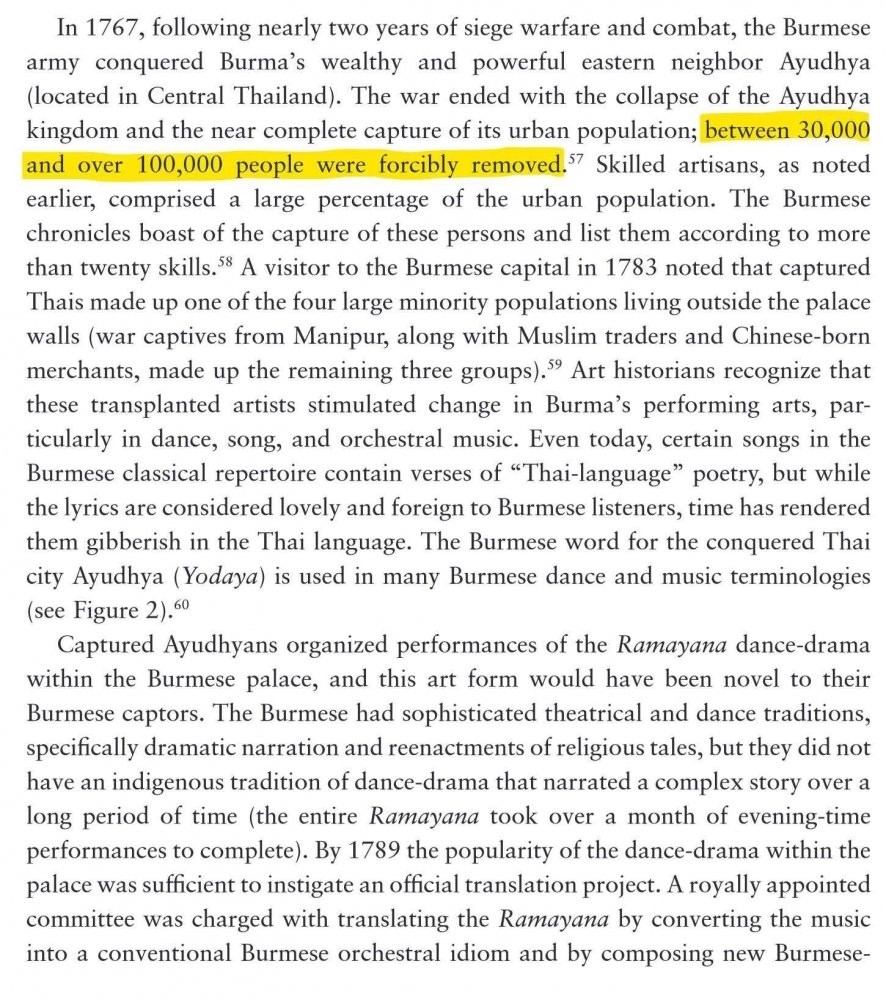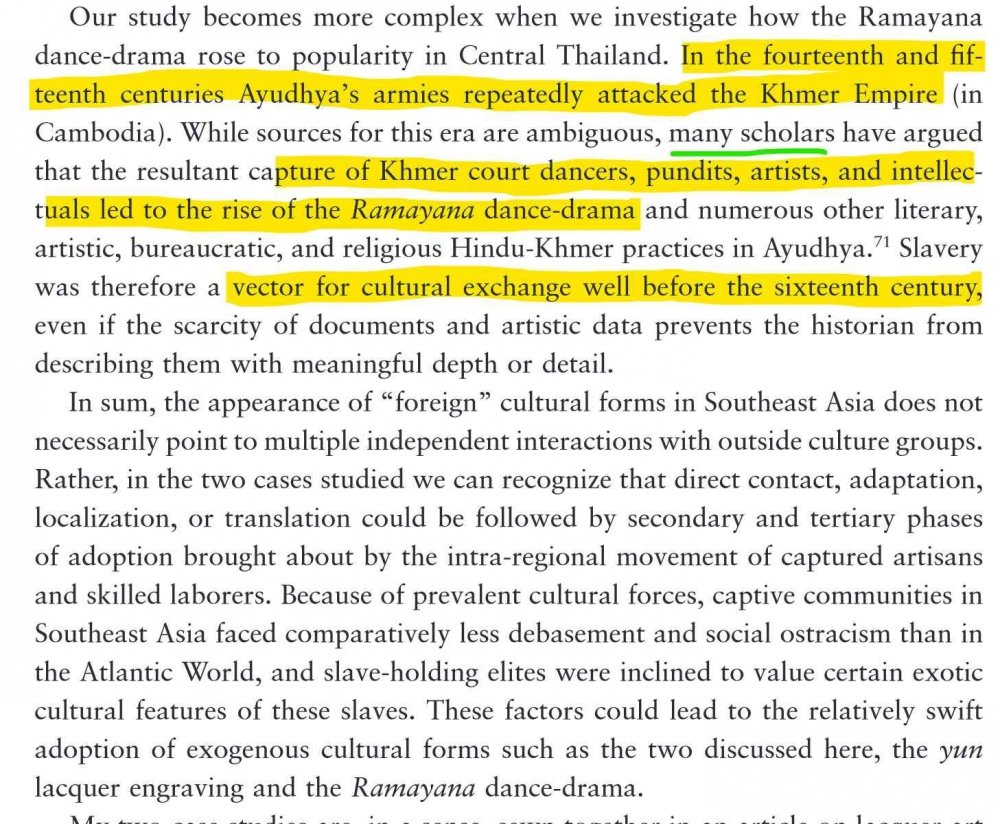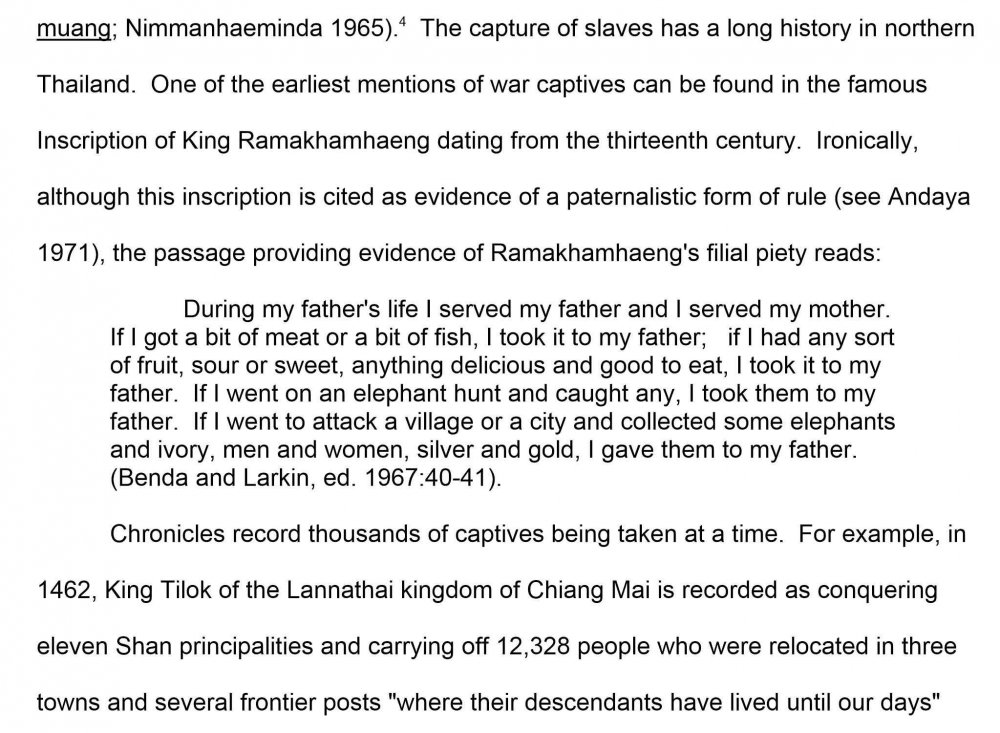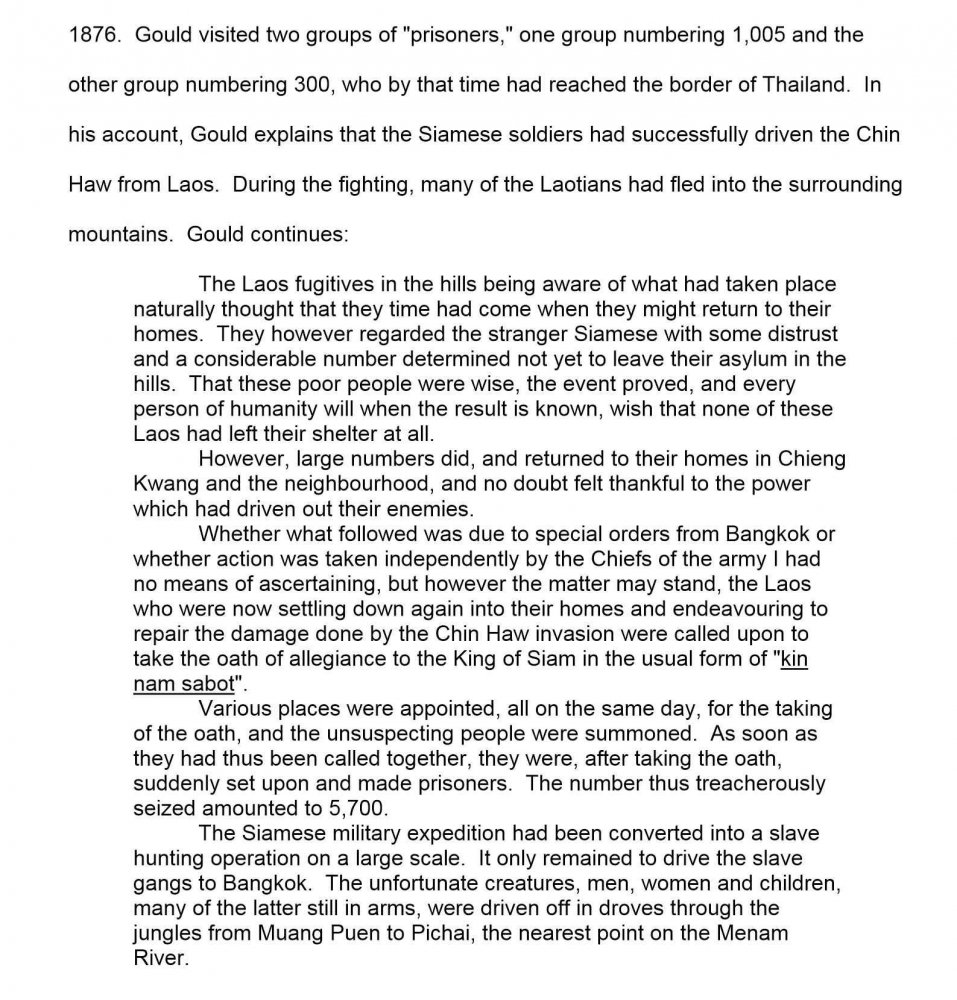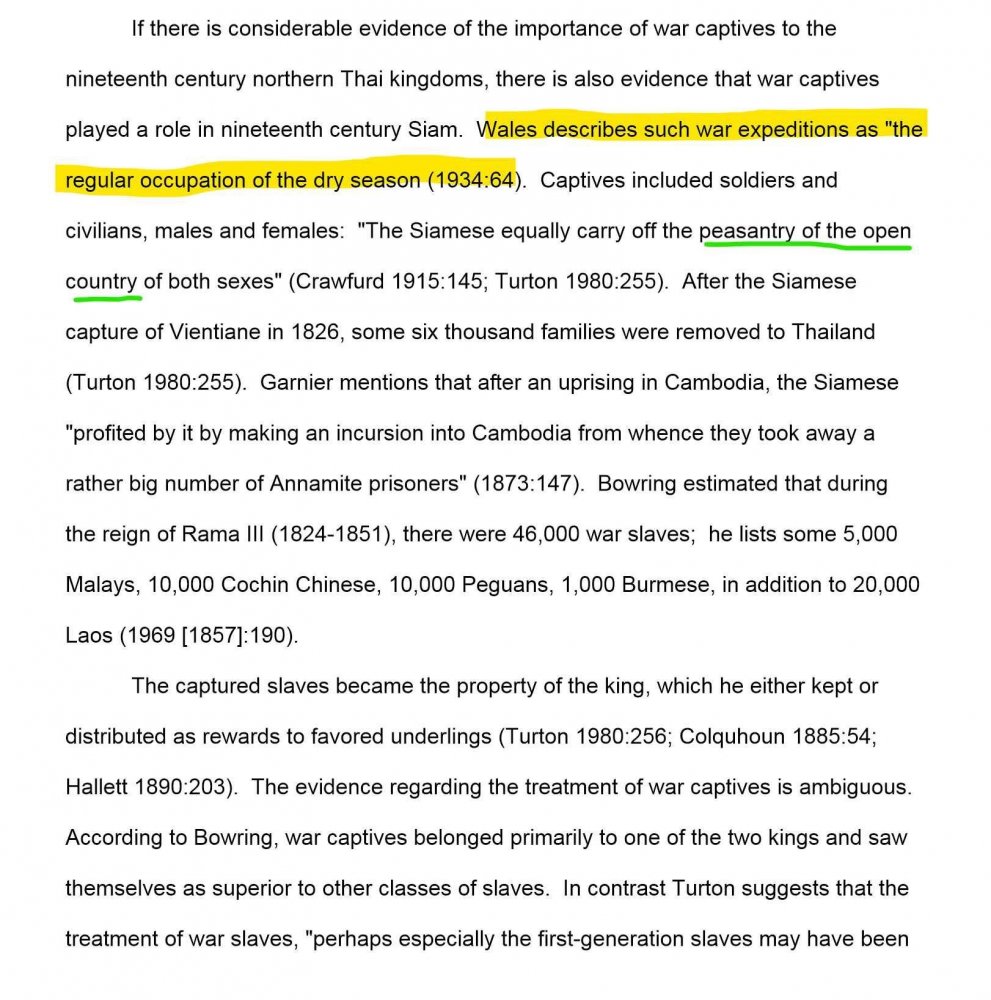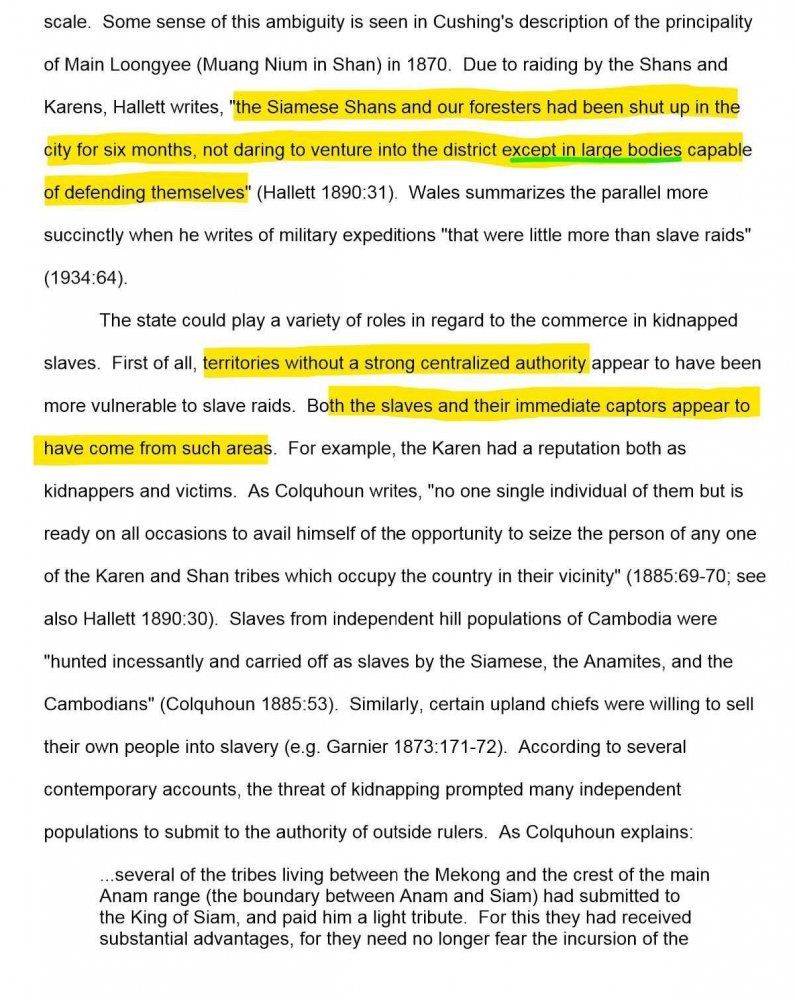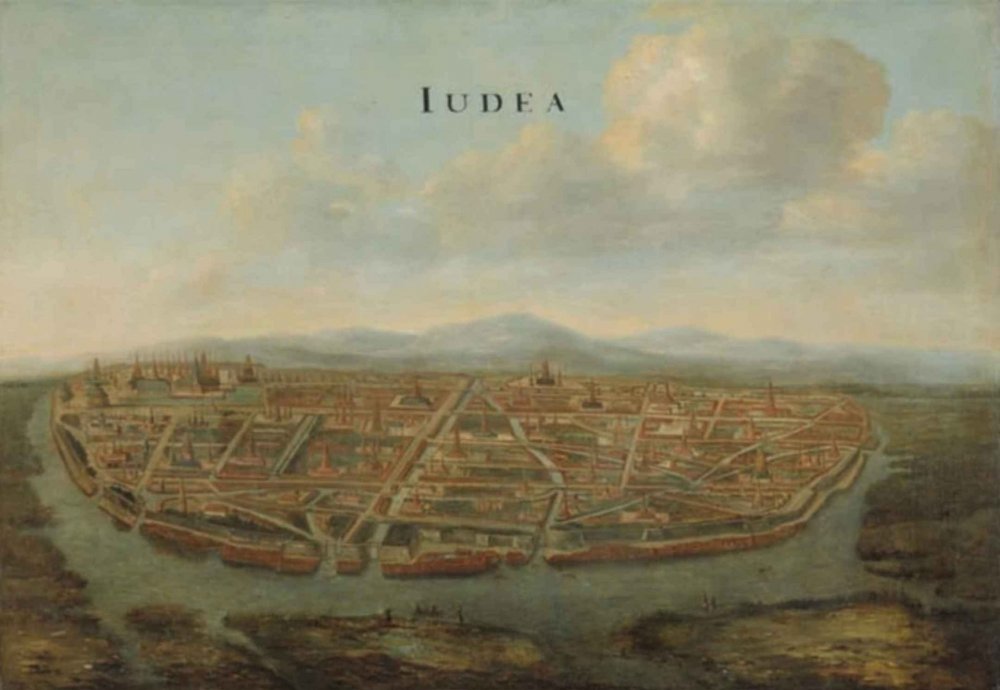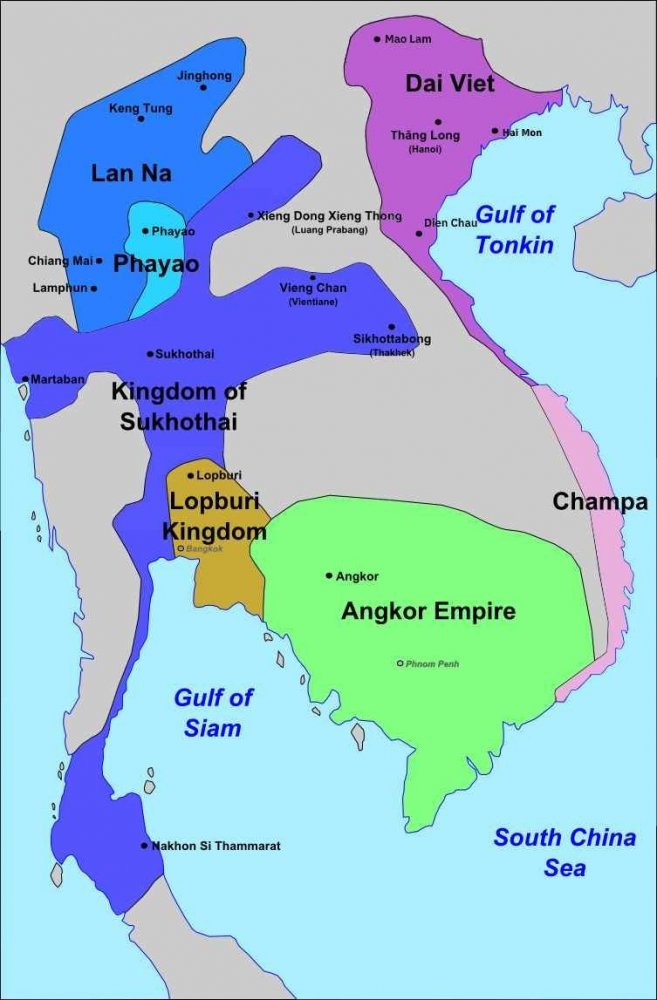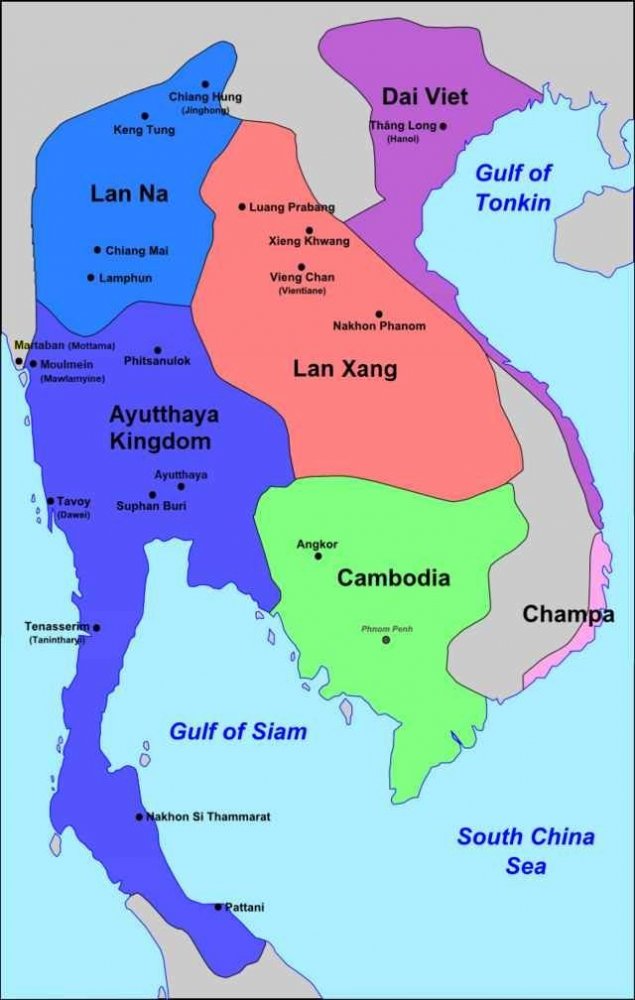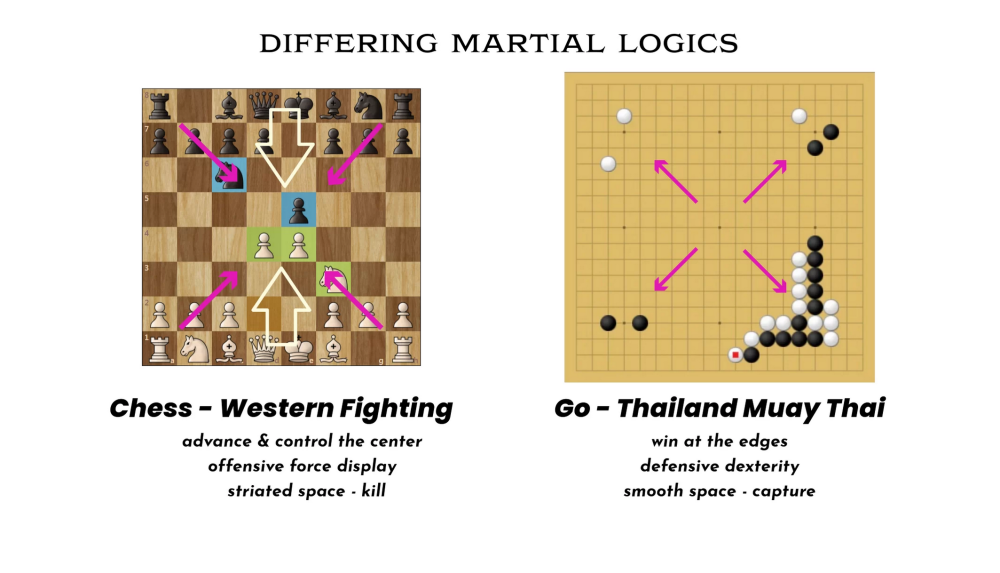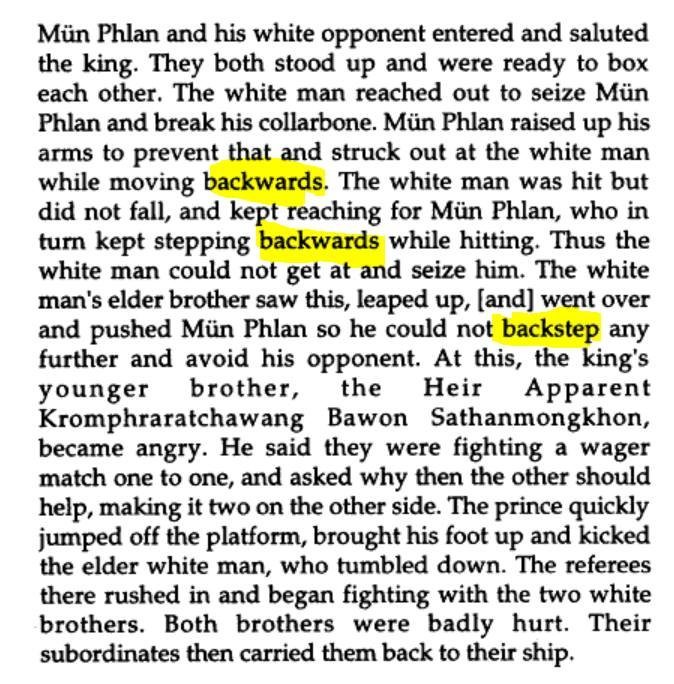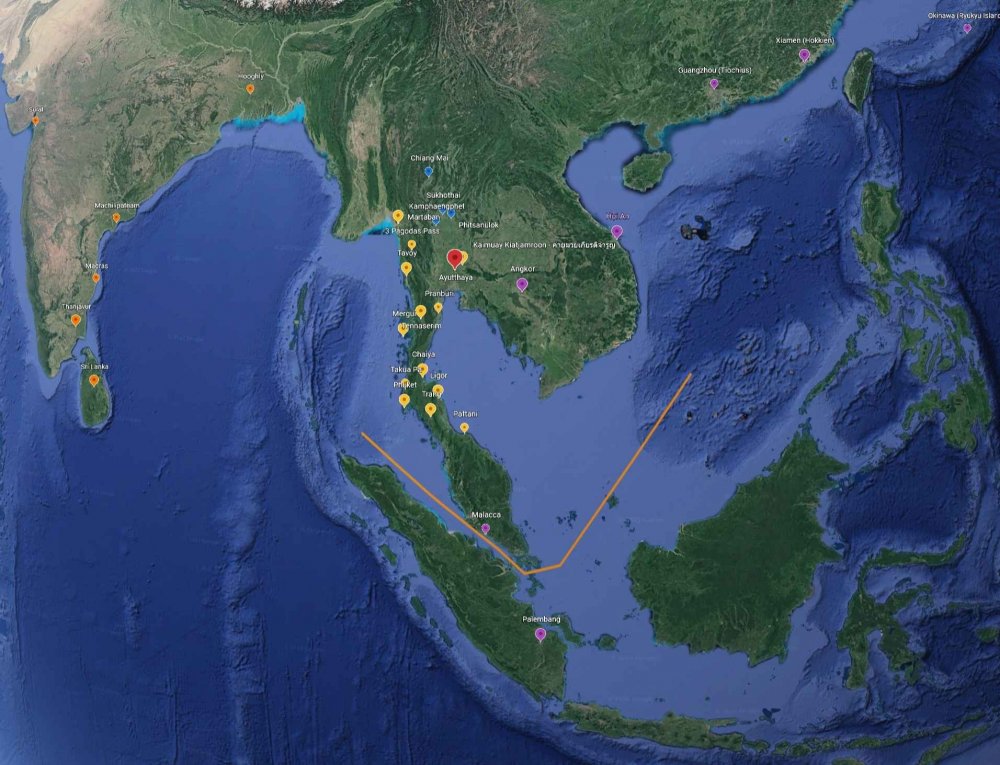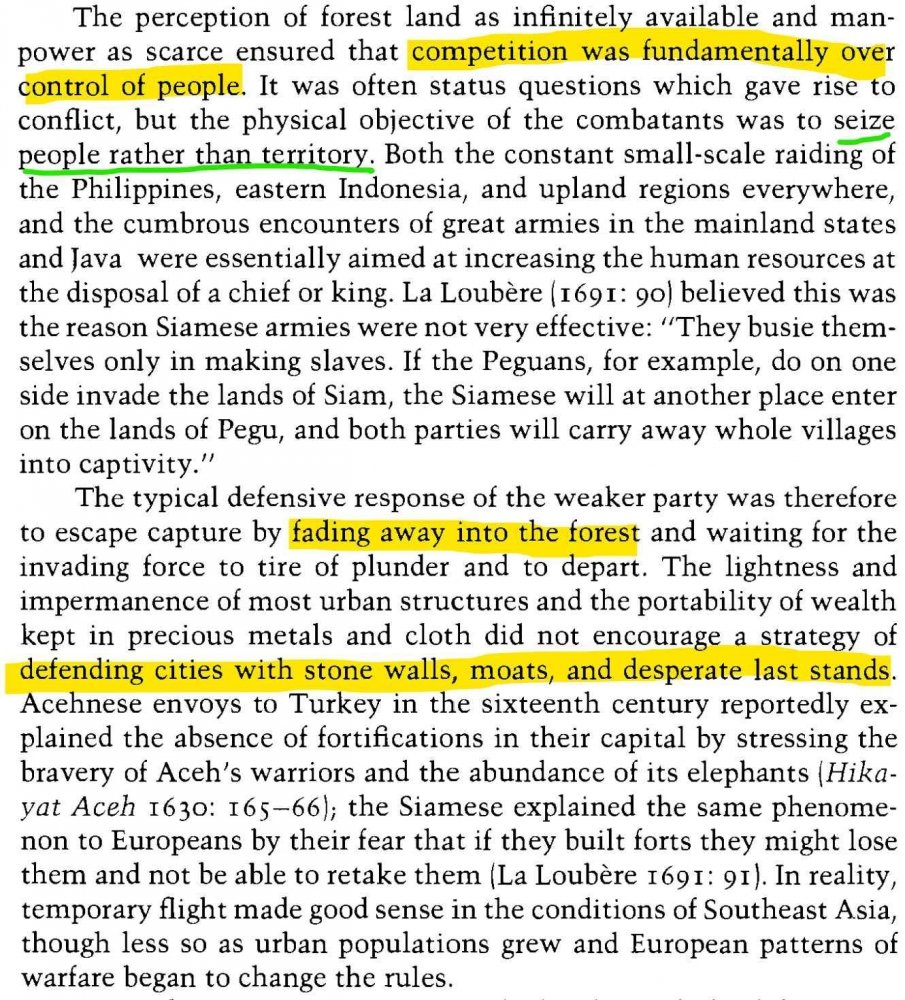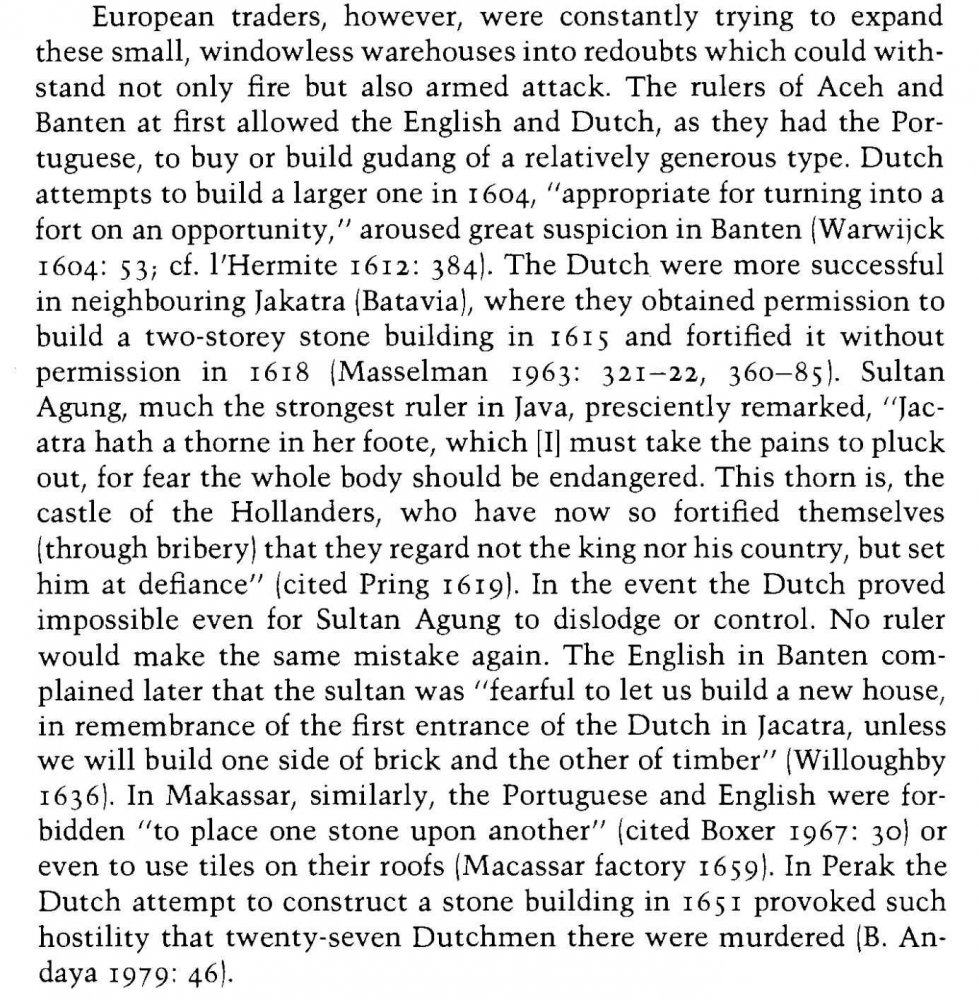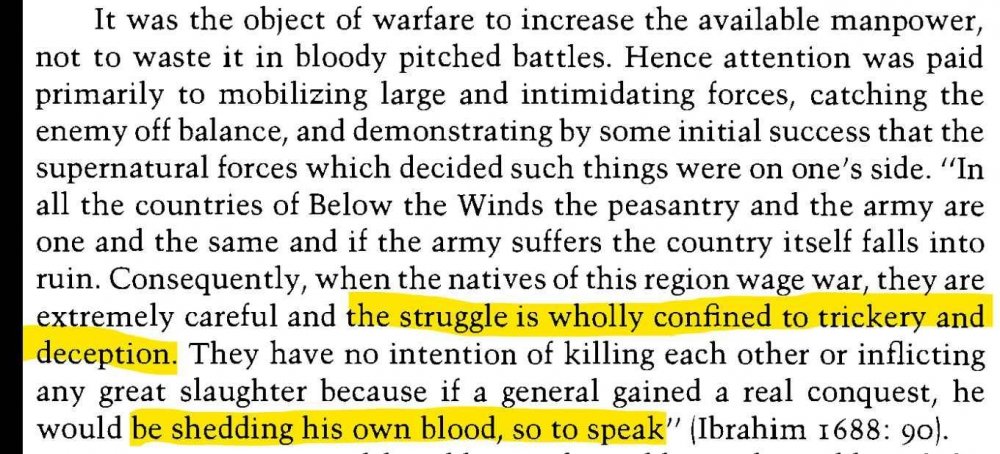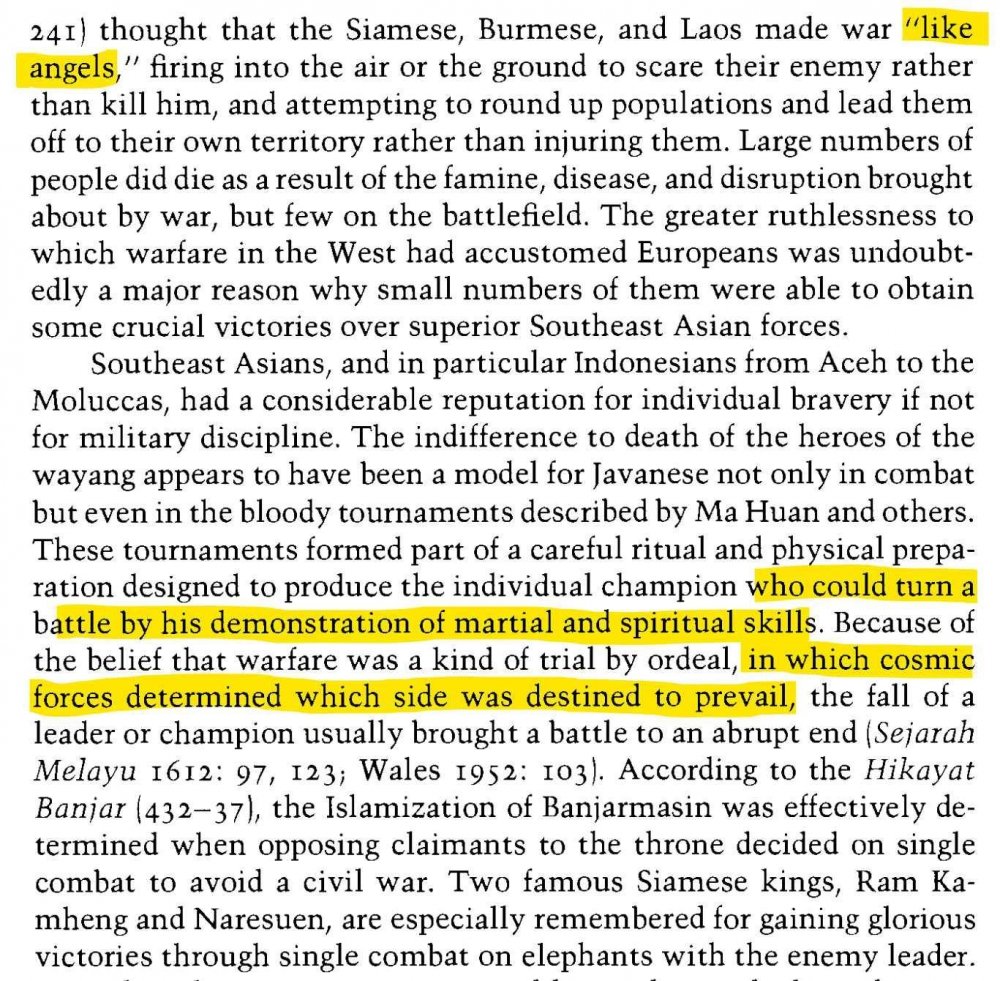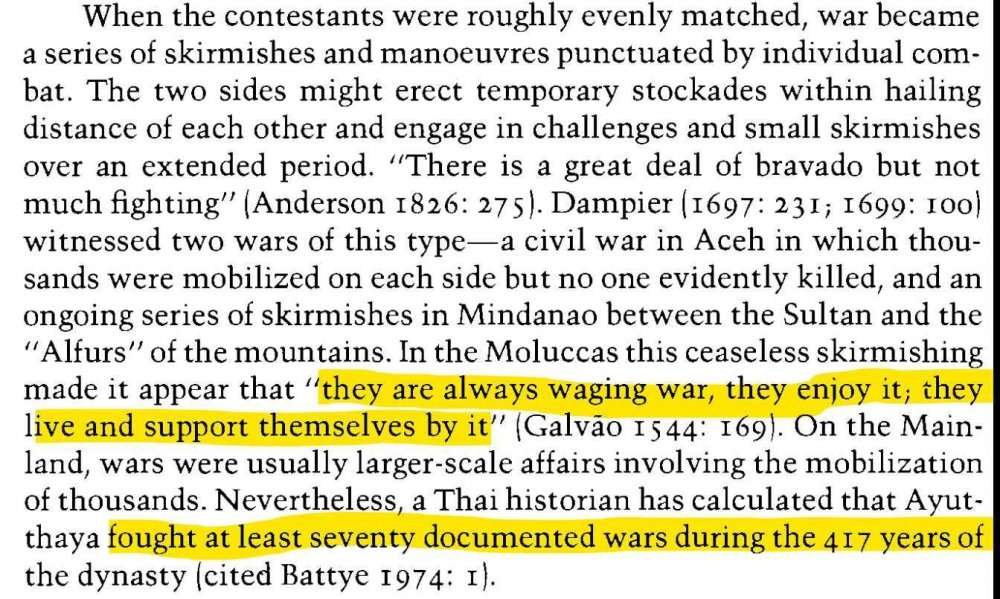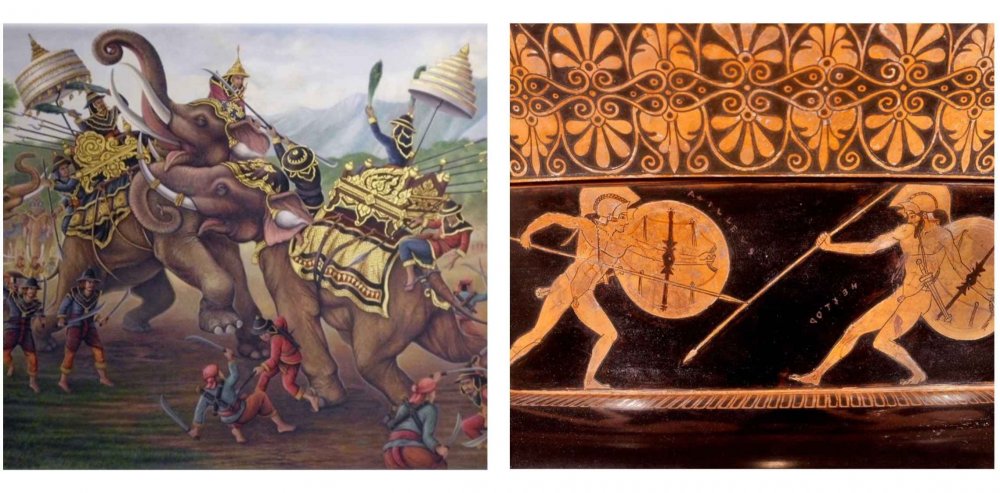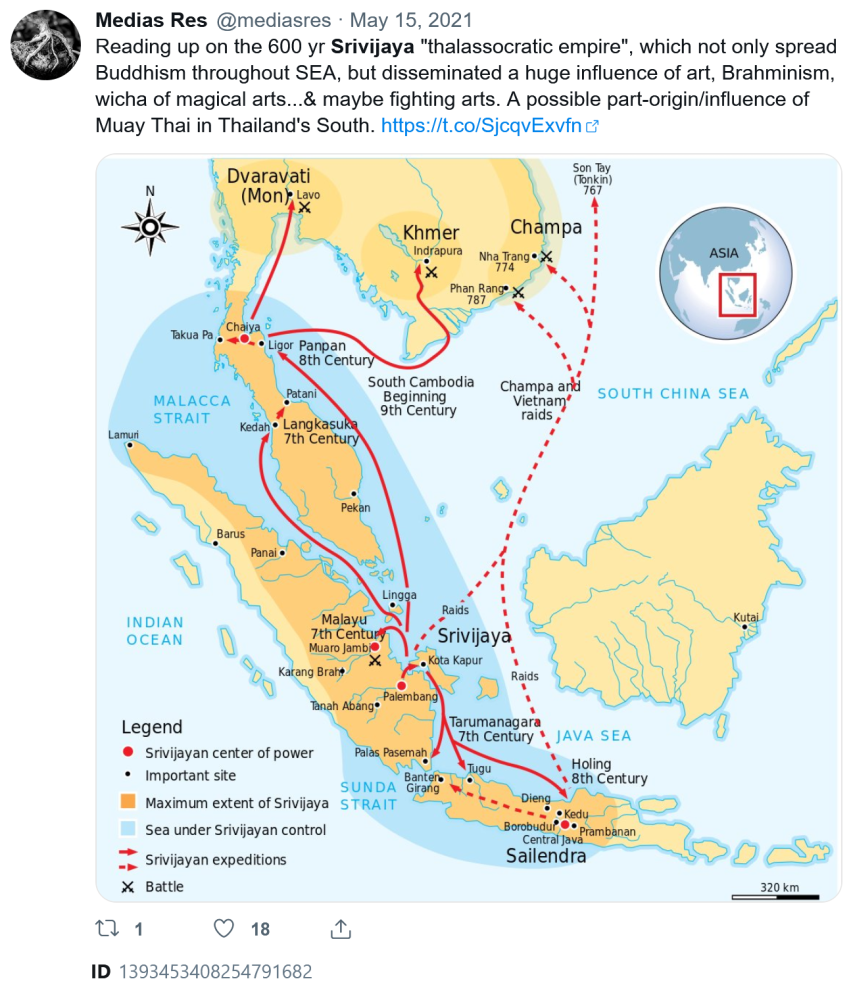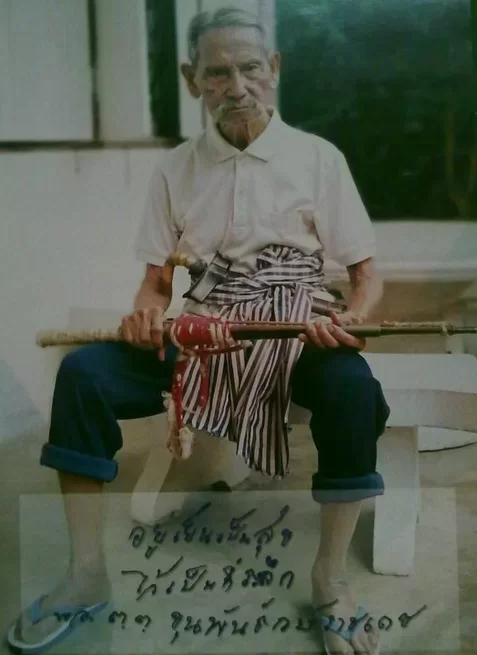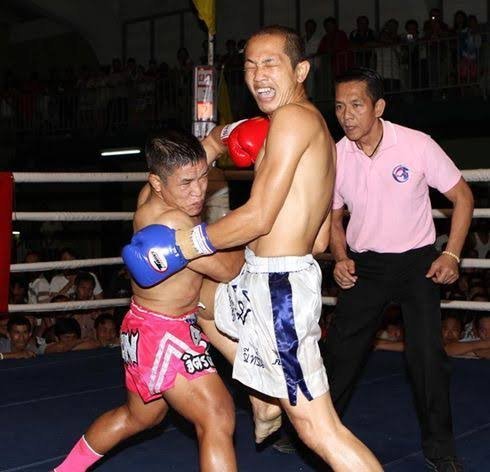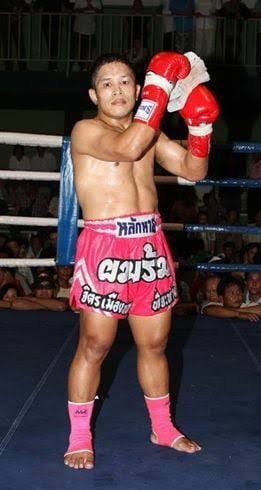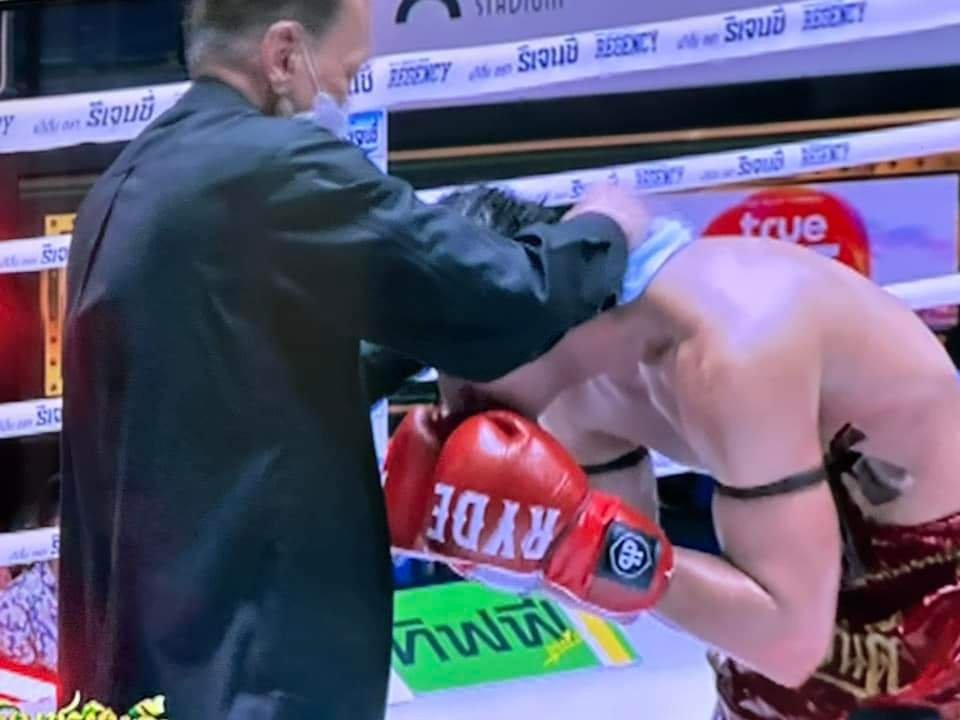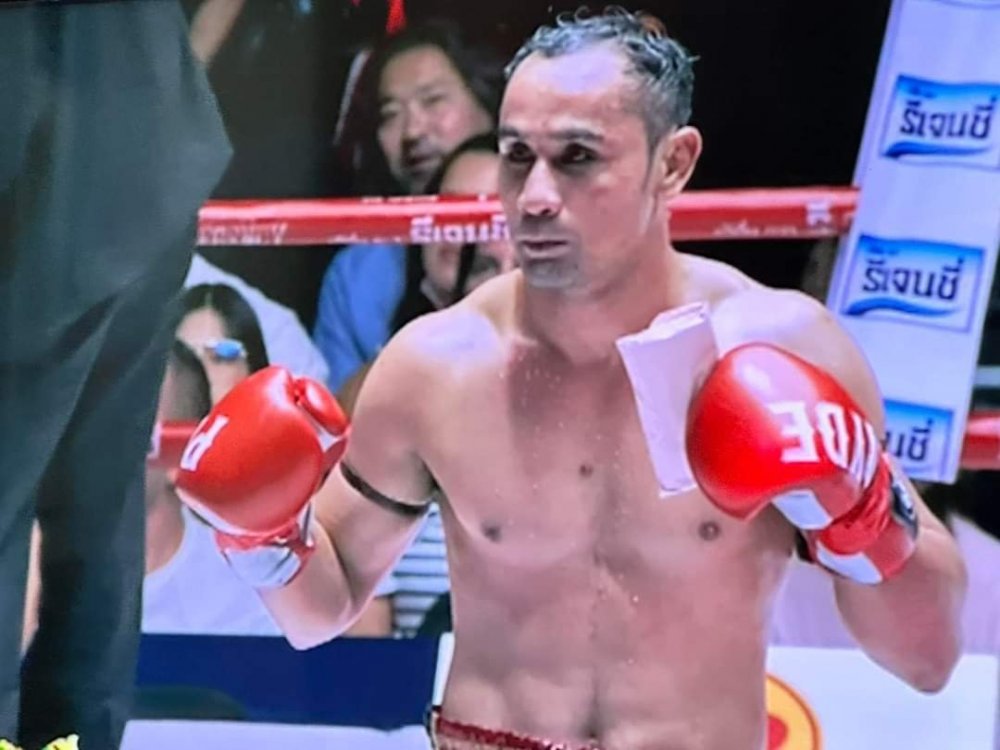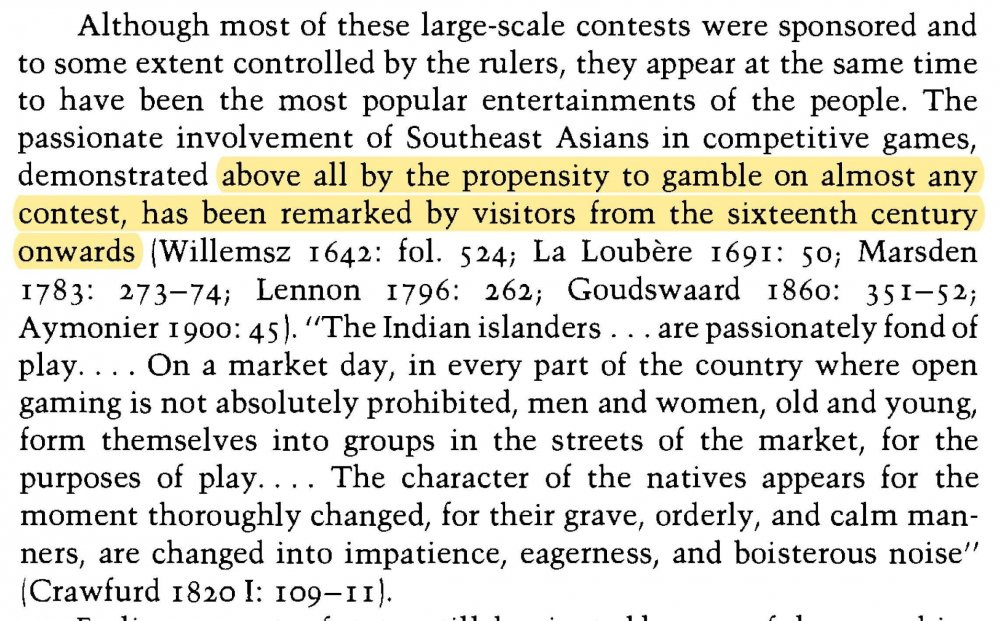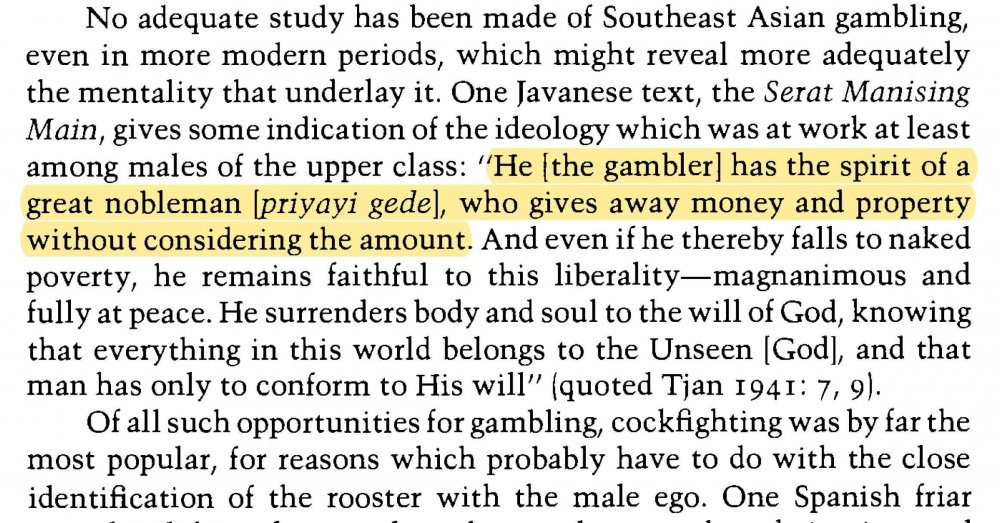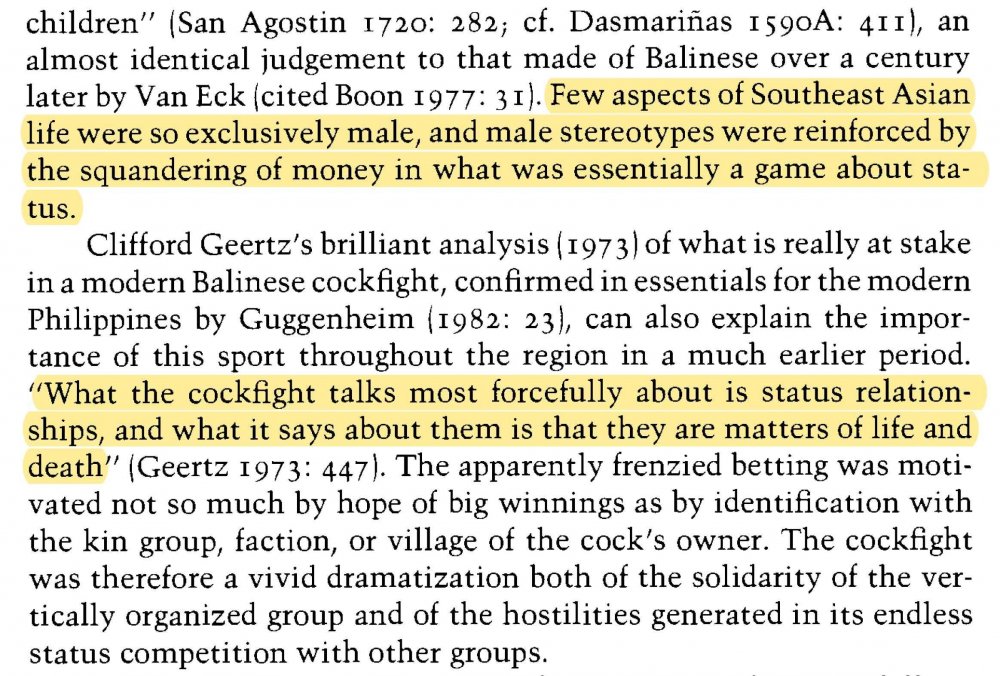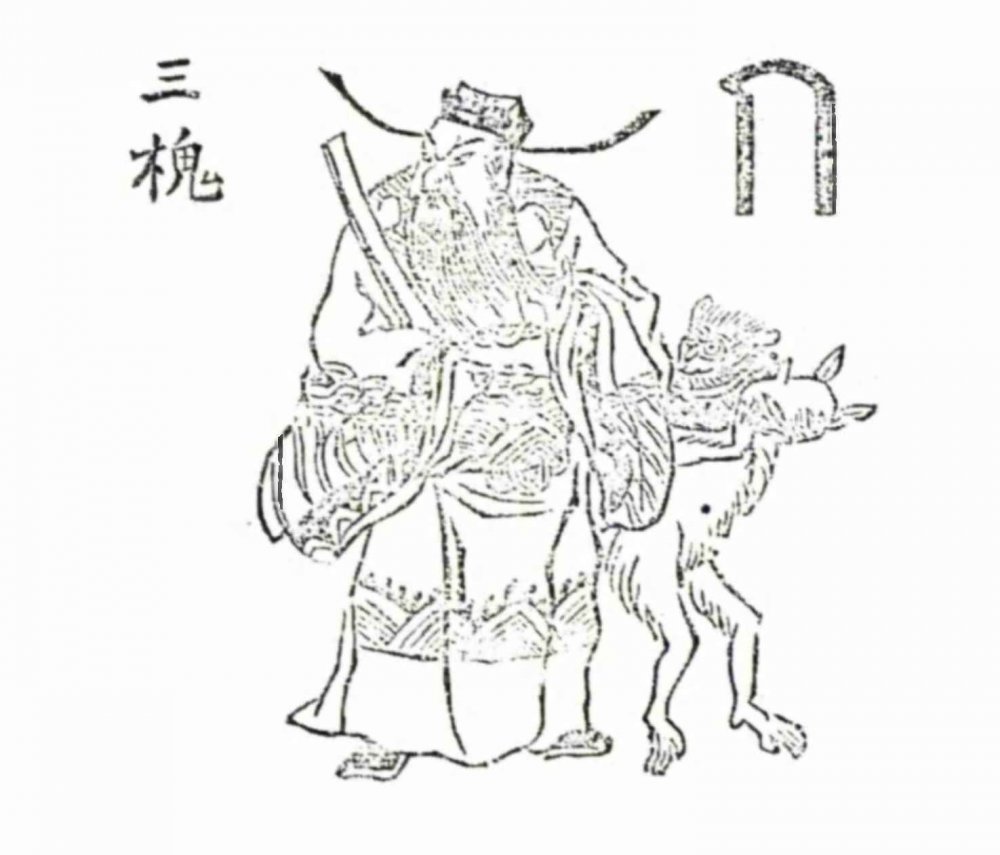-
Posts
2,264 -
Joined
-
Days Won
499
Everything posted by Kevin von Duuglas-Ittu
-
Scott's book on Southeast Asia, though from an anti-Statist, or State-critical perspective, provides a very good sense of the systematic aspects of just why States (and likely much smaller statelets, rural elites, and other competing centers of power) became such warfare, slave-taking states. It was very difficult to maintain acquired manpower. They regularly experienced manpower drain. These centuries upon centuries of warfare, slave-capture cultures of agonism is the bed in which Siamese Muay Thai grew. Firstly he points out that mandala Kingdoms themselves overlapped, so peoples were constantly shifting in their penumbra: Here he describes the perpetual struggle for slave-taking manpower in SEA, something that points the eye away from just the occasional large Kingdom, siege-centered, more bloody battles, and likely annual "Dry Season" (War Season), localized strife. This was an agonistic landscape. screen caps from The Art of Not Being Governed: The enduring question, at least for me, is whether this agonism was in fact annual, if there were local political strifes that were more or less continuous because this manpower economic logic pervaded. This question would endure because of the obvious lacuna in the historical record, as it is large Kingdoms that have written their histories. An alternate dimension of this very integrative aspect of Kingdom manpower churn is that Kingdoms had to create very strong yet supple identities that could persist over time, something I think which typified the unique quality of Siam and then Thailand:
-
If you've followed my write up on the history of warfare in Southeast Asia with a view to why Thailand's Muay Thai may have favored a defensive, retreating style, two citations in that series come from The Ship of Sulaiman, an Iranian report of the court of Ayutthaya in the last 17th century. You can see the full thread write up linked at bottom. But as these citations are important in the picture building of Anthony Reid I want to footnote them here and include the much longer original passage in which they are included. They describe the most symbolic forms of warfare in Siam and Burma, and express the purported reasoning behind the "capture-not-kill" logic of region. Because labor was more important than territory, very blood battles were not favored, because you would be killing those who could labor for you, or at the very least pay tribute from their labor. Here is the citation: Things that stand out are: emphasizing that this is a recount of a battle hundreds of years in the past; the description of warring forces to music, a logic of surrounding capture employing feints and deceptions not only invokes some of the more stylized aspects of Thailand's Muay Thai, but also the spatial logic of the game of Go that I reference in the longer write up; and, the Siamese version of events describe how trickery was used to defeat a much larger/stronger foe in the Burmese prince, including the use of a firearm. The story continues onto another episode of deception when the Burmese seek revenge. At least in some measure there is a pride of winning vs larger/stronger opposition through intelligence and deception, a trait that matches up with other aspects of Muay Thai's retreating style, and the modern Muay Femeu vs Muay Khao dyad, in which the femeu fighter is favored by score.
-
I'm putting this citation and screen cap here as a placeholder. To review, my thesis is that cockfighting in Southeast Asia stood in for singular animal sacrifice rituals (instead of sacrificing a cock, having two of them fight), a singular animal sacrifice which ultimately was a stand in for the very ancient Vedic sacrifice of humans. The expiation of sin through sacrifice contains its own ritual logic, and when cocks fight the real ritual aim was for the production of a victim, a loser. This logic of the excluded one can take on a scapegoat power of purification. One of the weaker assumptions may have been my intuition that cock fighting was an expression of an older singular animal sacrifice. This passage in Anthony Reid's Southeast Asia in the Age of Commerce, 1450-1680: The Lands Below The Winds, brings out this under logic quite powerfully, and records draconian consequences in cases where the King is being represented by a cock: The social group sacrificial power of winning and losing is confirmed, and the representational power of winners as well. Of course this wasn't expressed at the village level of Balinese cockfighting (as Geertz studied), nor at the village level in Siam, but it points towards a structuring logic of sacrificial rite and social capital achieved through winning and losing in staged combat.
-
Muay Thai is favored in that it has developed through many documented full-contact fightings. Fighters have records in the 100s, so they develop a more applicable, usable style. Someone like Samart Payakaroon of Thailand was/is probably the closest thing to the kind of national hero that you seem to mean. He was both a Muay Thai champion many times, and a WBC World Boxing champion as well.
-
Further reading, "Southeast Asian Slavery and Slave - Gathering Warfare as a Vector for Cultural Transmission: The Case of Burma and Thailand" by Bryce Beemer, which describes Siam vs Burmese slave taking warfare and works to show how slave taking became an avenue of cultural transmission, tracing how Ayutthaya slaves brought both Chinese and Indian arts/technology to the Burmese. screen caps: and (if artisans and skilled craftsman of every sort were taken in slave capture, and seeded those arts in the new country, one must presume that skilled fighters as well were prized, and that the Siamese art of fighting also became an influence (and may have been influenced) by transmissions such as these): and (the special care for artisan captures, one suspects, would also be mirrored for any highly skilled fighter. The 18th century story of Nai Khanom Tom, who was captured and beat 10 Burmese fighters in a contest before a Burmese King and rewarded, considered a father of Muay Thai, may actually be a story of Muay Thai transmission, as he was said to be granted a change in social status, said to be "free" but perhaps more likely the social status of ahmu-dan, in the possession of the King (exempt from state taxes and levies on labor), and given wives/wife indicating some integrative position within the Burmese culture (the mythography of the event based on only 8 verses of a Burmese chronicle) as martial arts were likely valued. cont. note, in the above it is the majoritarian view of precolonial Thai slavery, that it was embedded in a much wider client/patron social hierarchy, and was not nearly as brutal as the Atlantic slave trade in the Americas. Katherine Bowie's article (cited in the thread above this one, takes a contrarian view to most anthropological takes, bringing evidence that warfare slaves were very harshly treated and suffered trauma from dislocation. She critiques what she sees as a general erasure of captured slave suffering in Southeast Asia in the literature. and, on the transmission of the Ramayana dance to Burma. Between 30,000 and 100,000 slaves are thought to have been taken in the fall of Ayutthaya. and the Ramayana dance performance may itself have been transmitted through Ayutthaya slave warfare captures from the Khmer Empire several centuries prior: It's very hard to imagine that the fighting art of Muay Boran (Muay Thai) and its occasions was not significantly shaped by these very large population and artisan migrations between regions of Southeast Asia.
-
Background reading to give a sense of the full scope of slave taking in Siam, the article below examines the historical evidence that in Chiang Mai in the 19th century by some estimates 3/4 of the population was slave, most of them taken through warfare. Because of this extensive raiding culture, and small scale kidnapping throughout Siam perhaps Muay Thai as a martial art needs to be evaluated as a developed necessary means of provincial village autonomy and self preservation, as well as a Kingdom military power. In this context the ordination of young men/boys in temples, and the teaching of Muay Thai in temples takes on a dimension of protection. This essay paints an extremely agonistic picture of life. "Slavery in Nineteenth-Century Northern Thailand: Archival Anecdotes and Village Voices" (Katherine A Bowie, 1996) PDF attached Slavery_in_Nineteenth_Century_Northern_T.pdf screen cap and, and, and, and, and,
-
Putting This In Perspective For me this study of possible deeper thematic roots of Thailand's Muay Thai starts with the historical record of the 1788 fight vs a Frenchman. The context of the fight was that it was set in order to improve Siam's standing internationally, its reputation. This is only two decades after the fall of the Siam capital of Ayutthaya to the North, and six years after the founding of modern day Bangkok as the new capital, closer to the sea. Rama I was the first king of the new Chaktri dynasty. Siam's reputation needed to be reestablished. It is notable that a symbolic boxing fight, a sport fight, would be the means of doing so (not all that different than the ideologies at play in today's farang vs Thai sport match-ups). source: Peter Vail's Modern Muay Thai mythology The report is from the The Dynastic Chronicles, so I believe this is from the Siamese point of view. The Siamese's fighter is portrayed favorably. His retreat is not ill-regarded. It is a moment of great public face, and one imagines the behavior of both French brothers is seen as humiliated and disgraced. It never occurs to the Siamese report that, against probably a much larger man (who was seen as trying to break his opponent's collarbone), one should stand one's ground in some sort of stand-and-bang glory. Instead the retreating, defensive fighting is seen as exemplary, one would imagine. And the loss of control by the aggressor as shameful and punished. These are themes we still see today when Westerners face Thais in traditional Muay Thai (though this is being up-ended in Entertainment Muay Thai). I think it important to see that the Anthony Reid book takes a very wide view. Perhaps a 10,000 foot view, towards the Southeast Asian culture during this time of trade, and it could not be the case that these themes he brings out are definitive of Siamese practices. From this we can extract themes of warfare liquidity, come out of the raid and plunder combat, the material abundance of land & the scarcity of labor as shared broadly across Southeast Asia, but this isn't to say that there were not also fortified martial territories which would complexify the picture. Ayutthaya itself was quite fortified, surrounded by a moat made from the river bend. A painting of the city from the 17th century: Siege concepts were a significant part of warfare and in fact the fall of Ayutthaya was the result of a 14 month siege by the Burmese. As early as the 14th century there is report of a portion of the moat wall of Chiang Mai being knocked down by what may have been a proto-cannon, told in Chronicles of Ayutthaya. Lengthy sieges of fortified towns & cities were common in the North. Temples may have been the most fortified local architecture during some periods of history. Warfare was not of a completely liquid territorial logic. It was mixed, and any land fortification, port or river mouth or straight could become a center point of control. The "Bang" in Bangkok indicates a river bend which was seen as a favorable defensive positioning, a kind of Nature's moat. Topography shapes combat. It is rather to introduce this 10,000 foot view of slave capture and water-trade liquidity into the picture of the development of Muay Thai combat logic, and to see that there are themes of "capture over kill" and "retreat over stand your ground" that likely ran through the wider culture of the region. And that martial logics are better seen also in the context of economic material means, as well as within the values of Buddhism which has shaped the culture for centuries. I've written a sketch of some of the possible water-y influences on the Ayutthaya Kingdom in this series of posts, if you want to read it into just how cosmopolitan Ayutthaya was as a sea-faring empire: I introduce the notions of watery, fluid combat because in many ways the dynamics of Southeast Asia go against some Western conceptions (and combat ethics) inherited from different material conditions. Bringing out these dynamics in some ways involves over-emphasizing them, so they they are more clear in bold-relief. If there is a more watery, less spatially centered, capture martial logic perhaps the game of Go presents an analogical example. Thought to be the oldest board game, originating in China, one can see that its spatial logic tends towards the corners and the edges, when compared to something like chess which favors the center of the board and features concepts of fortification. In the tweeted video below you can see this Go patterning: [Originally this article held a video of the patterns in a Game of Go, which I've re-posted from YouTube, adding to this this article discusses the patterns of Go vs the Game of Chess in the martial logic of Muay Thai:] Muay Thai’s Edge Excellence, Southeast Asian Capture Warfare & The Game of Chess It's tempting, without a detailed, fleshed-out historical record available to us to see continuity between the martial logic of localized capture in the game of Go and the willingness of Thai Muay Thai fighters to go to the ropes (or even sometimes the corners) to battle out their exchanges. Is there a deeper land vs labor, slave economy material logic behind these differences? Perhaps. If you play the video above it could very well be graphing out positions taken by a femeur fighter in Muay Thai. It is enough to perhaps use the game of Go (with its very different ruleset and topography) to suggest that the traditional Thai stadium Muay Thai is a different sort of game than some forms of combat sport fighting. And in that difference nurtured a particularly high level of skill development toward an excellence in defensive fighting. Thais learned to get really good at doing certain kinds of things because of how sport fighting is viewed and valued in the culture, and some of those values likely go back a very long way in history. provisional note: In thinking about the wateriness, or liquidity of martial territory and victory aims I'm also interested in how water itself may have played a role in skill development. There is some, very brief historical evidence that Siamese fighters were adept at "fighting on water, in a report back to China about the kingdom of Xian (Siam?). A switching, ambidextrous style would actually be much more favorable on unstable platforms like fighting on boats, as a single step can rebalance you. Some of the oldest forms of Muay Thai show a switching, ambidextrous base. Of course, we speak of Thailand (and Siam), and Muay Thai as if it were a singular thing, when in fact it is full of varieties and sometimes great differences. Just looking at the Kingdoms of the Region in the 13th century, and then again in the 16th (below) shows realms of culture that lasted for centuries. In terms of liquidity a northern Kingdom like Lan Na might share very little with the Southeast Asian cultures of trade commerce that Anthony Reid details. And the prolific Anchor Empire with its vast palace complexes might have a differing territorial logic than regions closer to the sea. But each may have had the same liquidity brought by land vs labor slave economies which would produce the same "capture not kill" battle aims. Perhaps Northern and Khorat styles may reflect some of those inherited dispositions. On the other hand the Muay Thai of the Southern peninsula developed in very close proximity to the very "Asian Mediterranean Sea" dynamics that Reid articulates, for over 1,000 years caught in the confluence of India-Persian trade (and Chinese trade), an essential piece in maritime empires, it likely absorbed much of the martial liquidity of the trade basin. It was through this Southern peninsula connection that a majority of Buddhist influence came, and no doubt many martial practices.
-
Below is a string of readings, mostly organized around the history of Siamese and Southeast Asian culture, discussing the possible historical foundations of a distinctly defensive orientation to Thailand's Muay Thai. They do not compose a single argument, but rather are read as extensive notes, with each post working somewhat additively & independently. When a Frenchman Fought the King's Champion 1788 I've always been fascinated with the historical account of two French brothers fighting a Siamese champion in 1788. It is not only the oldest account of Siamese/Thai fighters facing off against a Westerner, it almost surreally acts out a fundamental misunderstanding between Thai and Western cultures which plays out to this day. Teleporting across more than 200 years it somehow explains the profound misunderstanding of how Thailand traditionally sees fights, and even helps explain the new "entertainment Muay Thai" type of promotional model of fighting, designed to help Westerners win fights in Thailand and abroad, by finally getting Thais to stop going backwards. First the account: The French fighter finds it incomprehensible why the Siamese champion is fighting in an evasive manner, especially when honor is so much at stake. The occasion is so humiliating that his younger brother jumps in and shoves the Siamese fighter so he cannot retreat. He is trying to force him to "stand his ground" in what surely was Eurocentrically imagined to be a "manly" and proper way of conducting a fight. I am reminded of when MAX Muay Thai (the first big promotion of "Entertainment Muay Thai") opened in Pattaya and Thai fighters were given instructions that "If you go back you will lose" when fighting the Westerners the promotion had in mind. This was actually written in Thai in the early days of the promotion in the handout they gave to fighters; there was no corresponding message in the English rules. In terms of commerce the argument was that this was to make fights more exciting to the average viewer, and this is certainly the kind of product they created. Lower skill level, often smaller Thais facing off against Western fighters under circumstances which favored the Western fighters, and produced many Western wins. Thai fighters who in their art had become excellent retreat and counter fighters - mostly due to the traditional scoring bias that rewards counter fighting, and a fight culture which reads the retreating, defending fighter as in the lead (quite in contrast with how Westerners can read retreating fighters) - were being stripped of perhaps their greatest weapon, space-taking counter fighting, to level or even tilt the playing field the other way. And indeed it took Thai fighters on the promotion perhaps more than a year or two to adjust to this fundamental change. No matter how many times they were told "Don't go backwards!" in these early years they still instinctively retreated when they had the lead. Reading the account from the 18th century, and the infuriated response of the French brothers hauntingly echoes forward into today's Entertainment Muay Thai shows. There must be something essentially Thai/Siamese about the retreating fighter for this cultural contrast and misunderstanding to have endured for more than two centuries. I've always argued that the answer to this is found within Buddhism itself, and how it regards the hotter emotions such as aggression, anger, fury, etc. Buddhism sees these peak emotions as a loss of control, whereas Westerners (and other Asian Cultures) may read them as peak experiences of self-expression, willing & desire. The Buddhistic appraisal of aggression and anger is an upside-down world to other cultural values of angered affects, and this played out in the form of traditional Muay Thai itself, giving shape & tremendous skill to the Thai fighter in a broad sense. (Traditional Muay Thai does have its own ritualistic contrast of defensive arts vs aggression in the customary contrast of Muay Femeu & Muay Khao pairing, but the ideological importance of that conflict is something not to dive into here, it's enough to understand that the overall bias towards reading the defensive, retreating fighter as the one who is in control, both of himself and his opponent, is a bias which has produced perhaps the best defensive fighters in the world.) For a long time I have used this Buddhistic explanation of the affects as a satisfying answer. But I was taken by surprise when reading about the history of Southeast Asian culture to discover that there are likely older, materialist explanations for the favoring of retreat in battle, aspects that likely blended well with Buddhism's prescriptives about the hotter emotions. What follows does not assert that there are no property, boundary-driven identity concepts in Thai culture, or in warfare. In fact Thai & likely Siam culture was diverse and historically quilted. Territoriality & fluidity are likely best seen in tension. There definitely has been territoriality and in a modern Nation State it can certainly be pronounced. Instead what follows draws out a particular history of a differing kind of economic martial logic in Southeast Asia & Siam, one that can lead to Western confusion. Wealth was Labor, Land Was Cheap (opposite of Europe) territory & identity I'll be citing from Southeast Asia in the Age of Commerce, 1450-1680: The Lands Below the Winds, by Anthony Reid, which proposes a commercially driven trade-culture that perhaps developed over thousands of years, linking and extracting from the two great cultural powers of China and India. Many in the West, including for a long time myself, think of Thailand (and Siam) somewhat in isolation, a distinct and almost unicorn culture (and in some ways it is), but the Ayutthaya Empire was a maritime, commercial trade empire, one of dozens that rose up and lasted for centuries at a time, over the millennia. Anthony Reid's book attempts to describe the culture of this region in more comprehensive terms, especially in the time of its greatest commercial power. In the map above you can see Ayutthaya positioned along this trade route (on a river route to rich Northern Siam trade resources, and connected to the sea by that river); but the Southeast Asian culture Reid is describing covers the entire trade basin, stretching down to Java and Sumatra, over to Vietnam and the Philippines, and up into the north below Chiang Mai. Thought to be much like Europe's incredible rich Mediterranean basin which connected Northern Africa, the Levant & Middle East, and Europe, this Southeast Asian basin of trade produced a flowering of culture, positioned between China and India. Reid's descriptions are of this basin culture. The first thing to note is that, broadly speaking, individual houses were made of perishable materials. The only buildings that were made of stone were palaces or temples. Transitory human habitation organized itself around symbolized permanence in the stone-built temple. Just in terms of architecture and practice we already see a contrast with Western values (at least how they came to be). The wide-spread perish-ability of personal housing made it such that rebuilding a house, or moving a house if damaged was relatively as easy as repairing it. Already one can be tempted into seeing the wood & thatch transience of human life in a Buddhistic sense, compared to the stone truths of religion (or royalty). Houses literally were built to be discarded in the event of raid or war, or nature's damage, which seeds a difference in how one regards one's personal space, and where identity is located. If we account for the idea that one's abode expresses one's personal center we can see that perishable, moveable housing presents a different conception of "self". But, this does not mean that housing was without meaning. In fact observers noted that the SEA perishable house was highly ordered. It presented a cosmos in miniature. This high-low hierarchy of holiness is expressed in Muay Thai scoring to this day (as well as pervading the culture). Houses were often raised off the ground to survive flooding. The ground was where waste and animals were kept. The family wealth of rice & ritual objects were kept in the rafters. Most important though, in this context of perishable housing, is how territory itself was perceived. Anthropologists of the world over make a very large distinction between cultures that develop in two ways (there are of course complexities and variations in this). There are cultures where land is widely available (cheap) and the thing that is scarce is the labor to work it (expensive). And there are cultures where land is scarce (expensive) and the labor is plentiful (cheap). As Reid describes the SEA culture of this era it is definitely of the former. If you would like to watch a very good lecture explaining the deep cultural ramifications of whether it's land or labor which is scare I highly recommend anthropologist David Graeber's Debt, Service, and the Origins of Capitalism (1 hr, 17 min) Again, very broadly speaking, there are two economic flows at this time: city state/empire mercantile powers which are centers of maritime trade, and those that develop out of a plenitude of land and the scarcity of labor. The 600 year Srivijaya maritime empire (tweet link below) is a good example of a mercantile sea trade power. The Siamese Ayutthaya trade empire arose after the Srivijaya fall. [originally there was an embedded Tweet Thread here, from my now private account, posting a cap with a link to further details in that thread] read further on the the 600 yr Srivijaya "thalassocratic empire" from the thread here For our purposes, thinking about how territory, identity and battle was conceived at this point the focus is on this fundamental economic dyad. A plethora of land, a shortage of labor to work enough of it to build wealth. Ayutthaya was a maritime trade power, drawing influences and wealth from all over the world, but it was surrounded by land that needed to be worked. And just north of Ayutthaya was even more fertile land. There is one basic answer to this question of labor...slavery. And in fact all over the SEA trade culture of labor scarcity the raiding of villages and cities for slaves was the primary engine of wealth development. Warfare was much less battle over territorial lines (over well-defined and defended spacial identities) as it was for the capture of slaves. All over SEA the impermanence of housing, the portability of wealth (precious metals, rice), and the scarcity of labor and the plenitude of land produced the core reality that retreat was far more effective than standing one's ground. In fact militarily battle was understood in a much more fluid, spatial way. Fortifications could be over taken, and if lost could themselves provide enemy anchors which would be hard to unseat. Instead battles were considered like waves of raiding. The enemy would come, capture, plunder and leave. For Western observers this mode of warfare was not esteemed, in fact it defied basic Western concepts of martial strength (produced by cultures where land is scarce and labor plentiful, the exact opposite of SEA's economic reality). You can see the possible, deeper origin behind Western conceptions of fighting (fortified, territory-oriented) and their confusion over SEA fighting (fluid, retreat-oriented), as exemplified in the 1788 fight between a Siamese champion and a Frenchman. These are two different martial logics. In fact in SEA there was an intersection between martial logic and commerce expressed in the architecture itself. Below is the lesson-learned example of Dutch traders building a stone storehouse for their goods, which they then fortified into a small castle from which they could not be uprooted. In the fluid world of raiding warfare and slave-taking wealth stacking stones was a significant martial danger, and in fact forbidden, or taken as an outright threat in some principalities. One can see that these are very different worlds produced by different economic (materialist) foundations, a different sense of what warfare and battle is. I'm going to leave aside the other half of this equation, making only a note here, which is that: these are maritime trading powers, and that water itself was a medium of culture whose properties manifested in tendencies opposite to those traditionally attributed to land. There is a historian's adage: "Land divides, water unites". Land encourages drawn lines, and the battle over those lines. Sea culture is much more spatially fluid, less visually distinct and demarcated. What is not included in that adage is that land (when land is scarce) is much more divided/territorial, but land (when land is plentiful) can also be fluid and less demarcated, when it is labor that is scarce. Maritime trade navies, mercenary warriors, sea-battles (and fighting styles that involve piracy and on-water fighting), because watery, produce a very different fluidity to the notion of power, authority and wealth. There is much less of a sense of "high ground" which would be citadeled and defended, and instead a more tactical topography of techniques. And water produces wealth through connection (exchange), not through isolation. Martial wateriness exists in the context of exchange & the lasting of connections. The fluidity of land based raiding, slave-taking warfare over perishable housing that encouraged retreat was mirrored by the spatial fluidity of maritime power and trade-lanes. In a sense the land can have a kind of maritime fluidity as well. Some Battles Not Very Bloody There is a very significant dimension of warfare in the context of slave-wealth, which is that you do not want a bloody, kill-everybody rout. Once you get to a point of dominance in a battle you are just killing off-your own wealth when you kill an enemy. The purpose of the raid is to capture, not kill. I'm not going to say that this is conclusive, but it certainly evokes the wide-spread Western confusion on why there are so very few knockouts in Thailand's traditional Muay Thai. Legends of the sport in the Golden Age might have 100s of fights but only a handful of knockouts. (Even Muay Boran knock-out-or-nothing, rope-bound fighting, an older form of sport Muay Thai, may have more been fights of attrition, much as the bound boxing fighting of Greeks & Romans.) The aim of much of contemporary Western fighting - the decapitation of the opponent - is missing. I talk a little about this cultural difference in this article: The Cowardice of the Knockout - Hellenic Greek Concepts of The Beauty of Boxing. In the larger sense, in SEA warfare was not about killing your enemy. It was about capturing and controlling them. This is to this day a foundation of Thailand's Muay Thai scoring (though this ethic is being challenged and changed by the new Entertainment models): The idea that you would be only "shedding your own blood" if you killed an enemy is quite alien to some of the Western concepts of warfare, because of the fundamental land vs labor equation. In SEA the fluidity of raiding battles, the value of retreat, the desire to control and not maim your enemy ended up producing a very important "symbolic" or signifying dimension to fighting, one in which a winning side demonstrates, (through skill & even magical superiority) that by cosmic forces they were destined to win. In fact, much as in Ancient Greece in the West (in the Iliad for instance), at times the battle was symbolically waged between charismatic leaders. Above, King Narsuan's elephant duel, and the battle between Achilles & Hector in Greek literature bear resemblance (the story of Nai Khanomtom, the purported father of Muay Thai is another example of symbolic warfare, but in this case as a captured slave), as they both idealize champion vs champion symbolic fighting, the results of which express the destiny or favor of cosmic forces. One can see how the mythologizing of great combat heroes of a culture (aside from debates of historical accuracy) plays into the ritualistic practice of sport fighting itself. Westerners (and those other cultures) can become quite frustrated with for instance the 5th round dance-offs in Thailand's Muay Thai - and there definitely are many factors involved, including the role of gambling - but when the 5th round is seen in the much wider 1,000 year heritage of combat itself, where the killing of an opponent is not the aim, and wherein symbolized superiority becomes quite important, it makes much more sense that once dominance is established the fight is over. To put it in a very short form, bending back to the first observations about perishable housing: one is not life-and-death defending a homestead, willing to die for this territorial x without which you are nothing; one is engaged in a warfare of dominance on a fluid battlefield, within which retreat - with transportable wealth - might make very good tactical sense. And with this sense comes cultural value. The acceding to symbolic loss is much more readable in the context of SEA warfare. Much has been made of the fact that contemporary Muay Thai fighters fight very often, and from a young age. This frequency, some say, explains why dance-offs happen in 5th rounds in Thailand, fighters saving themselves for another fight which can be in 21 days. And there is much sense to this. But the roots to this persistent fighting/symbolic dominance likely go back to a veritable culture of constant warfare, endless skirmishes, but also one in which the death of the enemy is not the aim. A very high level of skill was developed across of lifetime through repetition and a culture of contest. Muay Thai is perhaps the most brutal of combat sports, with incredible moments of violence and very technical skill, but it is likely couched in a history that regarded battle itself quite differently than the West, a Southeast Asian perpetuity of fighting. Thailand of course is a very different place than Siam trading principalities of the 16th century, and its Muay Thai certainly has adopted many aggressive tendencies and tactics in its dialogue with the West and other cultures. Siam/Thailand has been a nexus of trade and international martial influence for a very long time, but there is a very important regard in which Thailand's Muay Thai is essentially Thai. It expresses something that feels deeply seated, manifesting both its Buddhistic culture, but also the foundations of the land itself. There is a significant measure in which the very high art of retreat and counter defensive styles which are coded into its scoring and passionate appreciation (including the narrative structure of gambling interest) speaks to a very logic of warfare that is not that of the West (or of the more globalized world). Its capture and control methods of combat borne out of near constant fighting going back hundreds if not thousands of years are essentially Thai, even though they produce confusion in many who come from a different logic of warfare developed out of different material conditions (land vs labor). If we change the very logic of Thailand's Muay Thai to fit a non-Buddhistic, kill-over-capture ethic for commercial reasons there is some sense in which we are radically changing, and even erasing Muay Thai itself, its very grace and meaning, and with it what it has to say about combat. I suspect that in some manner the absolute and real violence of Thailand's Muay Thai, its heightened brutality through elite skill display that many outside of the culture are drawn to actually comes from its capture-not-kill, agonistic (yet Buddhistic) cultural roots, in which retreat and counter fighting is prized. Many confuse that violence with aggression and the aim to end the other, and do not see its watery, transitory foundations. Edit in: I went back and read the original source for some of the most "not very bloody" accounts of Siamese battle, to get more context for them. Here is that source material, The Ship of Sulaiman, an Iranian report of the court of Ayutthaya in the last 17th century:
-
Looking for a gym in BKK
Kevin von Duuglas-Ittu replied to 10e5x's topic in Gym Advice and Experiences
Attachai's is no longer in Bangkok. He moved his gym to Ayutthaya. -
Gym recommendation technique and teaching
Kevin von Duuglas-Ittu replied to TRTdoc's topic in Gym Advice and Experiences
Attachai Muay Thai has moved out of Bangkok to Ayutthaya (and I believe one other location location as well), I haven't heard if it is fully open, or any reviews of what training may be like in its new set up. He is a great instructor though, to be sure. Last I saw they were still constructing it, but that was some time ago. -
If you look at this clip from the documentary Lumpini (2018), a gambling boss bragging about his hidden (and not-so-hidden) control over a fight, you can see a homology between him and the clip further up this thread (4th post) from the film Necromancer 2020 (2019). The gambling preoccupation is with possible hidden influences, and the ability to read other minds/intentions, always with fairness creating a ballast. A gambling boss wants his ability to control fights to be seen (or more imagined) as a measure of his status, but always because a fight is not just between two single fighters, but their extension of social networks of power and investment, there is an element of cosmic justice on display. Magical powers, local political powers, are not entirely divorced in Thai history, as political power relies on aura & charm, and projected invulnerability & authority. Look back at the Necromancer 2020 clip. Something is happening in the fight. Something doesn't seem right. The man sniffs it out, it's someone manipulating the fight with magic behind a column in the lot. This is the exact same feeling gamblers have when watching a fight were the odds don't budge when a fighter they have bet on looks to be winning. What is it I don't know?
-
To see the detective, predictive work involved in the uncovering of "hidden forces" behind fights, and how Hia Now Petchyindee knew his own fighter Fahwanmai was throwing a fight, watch this discussion between himself and his son Sia Boat. (There are English Subtitles, turn on CC.). TLTR: in short, at weigh-in the odds were even, then at 5 then suddenly shifted to his opponent, and in the fight no matter how well the Petchyindee fighter did the odds wouldn't budge. People had inside information that the fight had been fixed with the Petchyindee fighter throwing it. Fahwanmai had a troubled past and Sia Boat had extended himself to him giving him a second chance, only to experience this betrayal. It's an important interview that shows the human and even brutal side of Muay Thai gambling corruption, with a lengthy confession ordeal between Sia Boat and his fighter. Just after the 14 minute mark Hia Now talks about the history of that particular gym's corruption, that the gym has drugged their own fighters. The complicated "what ifs" and who-dunnits of "hidden forces" move at almost a conspiratorial level: Hia Now talks about how a bottle of an energy drink at a stadium local 7-11 might be swapped out and put in the shelf, and watched over to see which (random) fighter might come in and buy it. Then gamblers would be alerted; or, about how if a gym sends their own fighters to train at another gym (one in Bangkok) that surrogate gym might fix, or "stage" a fight. This November 2021 video is a promotional attempt by Petchyindee to clear their name from the wrong doing, of course, but it works to also position Muay Thai within anti-corruption and gambling. Late appeals to Muay Thai's sacredness, and National identity are there to rebalance it, at a time of crisis.
-
To appreciate the closeness between magical beliefs (and the passed on technical knowledge to deploy those powers) and the technical knowledge of how to fight, at least in its historical sense, its best to read up on the life of the famed Thai policeman Khun Phantharakratchadet (1898–2006). In the link to the comment below you'll find two great resources. If this interests you, read both. His life embodied a particular kind of Southern hypermasculinity which helps one understand how magical power (knowledge, training) and martial powers (knowledge, training) go together with the creation of social status in the context of modernizing, civilizing Law itself. In short, he became a famous policeman imbued with magical knowledge & Muay Thai (and other fighting arts), who created an aura of invincibility and authority, walking the line between policeman and criminal (nakleng). His position, as a man, in the shifting political landscape expresses a very deep root in Thai male identity. Read about him here: Historically, as we apply these ideas to Muay Thai and gambling there are two basic aspects I would draw forward. The first is that magical technique and fighting technique were at one time seen as braided in Thailand. Many of those practices have now become unconscious or even thoughtless repetitions (the Ram Muay for instance that you see before fights is basically spell casting, and the summoning of supernatural powers. There was a time when the Ram Muay was much more diverse, and likely expressed the local beliefs and knowledges of one's gym/wat). The amulet of the prajet that every fighter wears (now, it is often just a cloth around the bicep, no longer holding an amulet) is a protective device. Still, Thailand's Muay Thai is imbued with these beliefs even at a vestigial manner. And I've even heard first hand of magical battle in the ring. above, Lakai If you know the very short Muay Thai fighter Lakai "The Alien", who now only does "show fight" appearances, if he's not retired; Sylvie's trainer in Chiang Mai Den told us of when he fought Lakai in a local match it was known that Lakai practiced magic. When he would go to the corner between rounds he would allow nobody to touch him, it was said. Den told us of how he defeated Lakai's magic by tying a piece of cloth into his anklet, a cloth that belonged to the skirt of his mother, and throwing a headkick over Lakai's head, veritably breaking his magic (I believe you can see this kick here, the first strike of the fight). The kick was actually a fusion of Muay Thai technique and magical technique. This fight is such a size mis-match the only way to lose, one suspects, is because of magic. This was maybe 12 years ago? So, the two are not completely divorced. The second aspect is that imagined magical influence from beyond the ring (as depicted in the film clip) serves as an analogy of beliefs in hidden influences in general. It is a placeholder for an entire world-view that one is constantly positioning oneself within networks of the propitious, both in terms of sociability, in one's own life (aligning oneself with powers that might influence your life in undue ways), and in terms of pragmatic power. Prosperity is governed by unseen causes, aside from supernatural beliefs, or political networks, is something that goes to Buddhistic beliefs in karma. But, as mentioned previously, it is also more than an analogy, as Thai masculinity of charismatic power involves not only vestigial aspects of magic beliefs, but also active beliefs and practices in the power of men of influence. As gym & gambling powers jostle for social status within the political scene of Muay Thai, they do this in part through their ability to appear to influence the outcome of fights in hidden ways, as marks of their power.
-
Moving away from the idea of the gambler, or the Big Man taking care of those aligned with him, there are very deep roots in Thai culture which I believe help give meaning to what is happening in Muay Thai gambling. I posted this thread on Twitter containing a scene from a recent Thai movie which depicts an underground fight being manipulated by just out of sight magic. I suggest that this notion of "unseen influence" actually makes up much of the passion and dynamic of gambling itself. In this case its superstition and powers of manipulation (beliefs that many contemporary Thais may not consciously hold), but this is not fundamentally different than others "hidden" means of manipulating a fight, from the drugging of fighters, buying off judges, or just exerting social status pressure over close decisions. It is part of a matrix of causal beliefs in hidden social forces. I transcribe the thread below, though its best if you watch the clip. Thread: To understand Muay Thai betting in Thailand I think one has to go deeper down into the very idea of "hidden influences" on events in the culture. This scene from the film Necromancer 2020 gives clue to how powers outside the ring are connected to fight outcomes. This is part of the lore of magic, male power & charm that helps shape how persons of influence are read. I would argue that ultimately, a powerful gambler pulling strings on the outcome of a fight, and a person using magical influence to win a fight are of the same cloth. The betting on Muay Thai in Thailand *involves* the possibility of undue influence, in fact influences are folded into the game of predicting which causes will effect the outcome of a fight. Historically magical techniques & fighting techniques were both taught in wats, both consisting of a *wicha* of battle and combat. But importantly, men of social power (those that could effect outcomes) held powers of persuasion & invulnerability as part of their social potency. We see two fighters "alone" in the ring. Thais see each fighter as expressing social networks of real political force & the powers of various wicha (if only the knowledge & practices of how to train a fighter and optimally prepare them for a fight). The lines between these kinds of powers, techniques & knowledges are blurred, and make up a metaphysical concept of what power & status is. The scene in the movie is a caricature of an underground fight & nefarious (criminal?) forces, but these beliefs are part of a much wider fabric of social magnetism, and hidden influences. When ppl gamble, they are betting on the sum of influences, which involves everything from physical preparation to hidden influences of powerful men, who in various subterfuges can become "string pullers", not entirely unlike the magic that is depicted in this film scene (by analogy). But, it's more than analogy, because in the very conception of hypermasculinity resides magical qualities of charismatic influence (ittiphon) & invulnerability (ittirut). This is not some exotic set of beliefs. We have it in the West as well. Charismatic leaders have a sense of unexplained power over others, and a certain untouchability, unkillability. A mafia boss that survives hits, a gunslinger that survives every showdown. This aura is perhaps humanly universal. But in Thai culture it unfolds in a unique concept of what technique, knowledge, magic & status are. What is happening in Thai Muay Thai gambling is that people are betting not only on the fighters, but on all possibilities of influence AND amid gamblers themselves a power struggle within these very rooted conceptions of power & status. Attempts to rationalize the Muay Thai fight, modernize it in a certain way, by removing audiences (as influence), removing gambling (& that power struggle), creating a kind of mathematical transparency, actually cuts all the cultural strings to those things outside the ring which make fighting meaningful. This isn't to say that corruption isn't a serious problem. It is because influence is always in tension with fairness, and a sense of fairness is what creates stability...but in Muay Thai it is that very tension that creates the dynamic of interest and passion.
-
Think about the Javenese description of "the gambler" in the Anthony Reid citation above: "The gambler has the spirit of a great nobleman, who gives away money and property without considering the amount". This feeling of largess and plenitude, of the man with powerful nobility who caretakes for those aligned with them, is found in Thai social status as well, in and out of gambling. Consider this - at least to me - touching moment when the Petchyindee patriarch Hia Now climbed into the ring and gave a 39 year old Sam A a 100,000 baht bonus. This was, I believe, an "injection" (money offered during a fight to propel a fighter forward. What makes this somewhat touching in the larger context. Sia Boat, the son of Hia Now, had just come off a personal (status) battle with Chatri Sityodtong who runs ONE Championship (a nouveau-style Muay Thai promotion inspired by MMA). Sia Boat had pulled all Petchyindee fighters out of ONE Championship in what looked to be a power struggle of social status within Thailand itself. Sia Boat, who has become something of a defacto spokesmen for promotional stadium Muay Thai, received a lot of blow back for the move, criticism that he was not looking out for the financial benefit for his fighters. This was the first fight involving a significant Petchyindee fighter following the pull out, and it featured a very Old School femeu, 39 year old Sam A, fighting in an old style of Muay Thai (not favored by ONE ruleset), vs a powerful, much larger, younger, aggressive PK opponent. Samingdam Chor.Ajalaboon. Sam A pulled off an unlikely win, demonstrating traditional femeu Thailand tactics, and Hia Now climbs into the ring and hands him the injection. It's a symbolic moment, more than it is a financial one. It goes back to that Javanese description of the gambler. The man of largess. The nobility of care out of prosperity, answering through the fight itself and this moment, the social media currents that may have turned against Petchyindee. Hia Now has been promoting fights for more than 50 years.
-
Here is the larger context of Anthony Reid's observations on betting in cockfighting from his Southeast Asia in the Age of Commerce, 1450-1680: The Lands Below the Winds. These are three screen cap paragraphs from the same section. They are speaking to the 500 year heritage of sport gambling in Southeast Asia, the social status positioning of the gambler, and the masculinity virtue that is expressed.
-
It's not just "Whose winning?"...it's also "Why have the odds not changed?!, or even "Why did the fighter take off his anklet between rounds 2 and 3, is that a signal?" One of the more interesting threads of thought in the movement toward a more "modern" Muay Thai is the idea that gambling needs to be purged from the sport. So strong a view it lead to the shutting down of the famed Lumpinee Stadium, and then its prospective reopening of it under the auspices of being simply an arena where modern MMA-inspired shows are presented, free of gambling. The moral approbation of gambling has a very long history in Thailand, going back to the early 1900s when the gambling houses of Siam were shut down (a gambling passion which had peaked with nearly 40% of state income coming from gambling taxation), as part of a larger moral reform, and Siam's move towards becoming more "civilized"/ Westernized (see The Quest for "Siwilai"). It was at the time not just a matter of moral reform, but also as a means to check the growing power of the Chinese run houses in Bangkok, their secret socieities, and the large and important Chinese worker/labor factions. By 1917 gambling was closed down by law, but in 1927 it was legalized for Muay Thai, leading to a boom in its popularity. If you want to read a detailed history of gambling in Siam/Thailand this is a great source: Gambling, the State and Society in Siam, c. 1880-1945 by James Alastair Warren: Gambling, the State and Society in Siam, c. 1880-19.pdf Leaving aside issues of problems with corruption and moral appropriateness, and just taking up the cultural form of gambling itself, what's interesting is that there is a kind of tension between a Western conception of gambling on sport (with the idea that transparency and pure fairness is essential), and what I suspect is a more Siamese/Thai conception of gambling on sport. There is a sense in which the very notion of undue influence on the outcome of a match is actually included in the betting practice itself. There is still a notion of fairness that grounds sport fighting, but the aim of the gambler is actually to also be betting on (or against) the powers that might also influence the outcome a match. These two things, fairness and influence are in tension. I think one can get insight into this in the incredibly popular huai lottery during the late 19th century which involved guessing (but much more properly studying) which figurative blocks of an alphabet would be chosen by the figure who ran the lottery. Below is a video scroll of the relevant description from James Warren's thesis. Note: They are betting on the influences in the huai lottery, in a form of detective work that examines a multitude of possible causes. Most importantly, such a lottery as it was conceived should not be random. A random lottery would lose interest it was reasoned. Bets were made on the basis of everything from lucky dates, the alliance of semantic meanings, to whether the selector had gone to temple, or his history of choices in the past. The lottery was actually a vast intuitional calculation of causes and forces. TLTR: Twice a day a lottery manager would pick a tile which bore a letter and a pictogram which they hung up on in sack. Networks of gambling prognostications which ended up extending into the provinces of which tile he would pick became a huge preoccupation. In a sense the lottery managers were also betting on which tiles betters would think they would pick, attempting to be both opaque, but also gambling themselves on gambler trends. Randomness can easily stand in for our modern conceptions of "fairness" or "transparency". Instead, the Siamese preoccupation was with the actual forces of possible influence. I suspect that these threads of the preoccupation with influence and forces can be pulled all the way up to contemporary times. Betters are gambling not only on the athletic outcome of a fight (may the best man - or woman - win!), but also upon all the external forces which may shape the fight, whether this is the ability of a powerful gambling faction to get the fight thrown, or to harden the odds to shape the decision, or a promoter to bias judging - or, much more subtly, on a particular gym's ability to prepare and guide a fighter (also an external influence). It is a theater of forces - that in a National stadia would literally be composed of audience members you could see. It is a detective work of not only skill, but also of other minds, reading what fighters might be thinking (or signaling), and the weighing of possible undue corrupting influences. Importantly, there is always a ballast of fairness, and always an outrage of corruption, but the act of betting is composed within the assumption, and actually ON the possibility of influences, extending beyond the ring. A reason for this is that sport gambling has its roots in the struggle for social status itself. One's ability to produce a winner is a show of potency and power, within a social group. A gym that can train a fighter well enough to win shows knowledge and power, but this cannot be ultimately separated from the knowledge and power of one's place within a social group, (which can be reflected in a gym's power to force a favorable match-up for their fighter, or to even harden the odds in their favor). Gambling is about aligning oneself within factional power. Follow from this 19th century report on cockfighting and gambling in Siam, Anthony Reid's status signifier interpretation of the meaning of bets placed (Southeast Asia in the Age of Commerce, 1450-1680: The Lands Below the Winds), if you've been to festival fighting in the provinces you'll recognize a continuity: In seeking to extract the (abstractly rationalized) sport from gambling history you are actually removing it from the very fabric of its meaning within the culture. This isn't to say that gambling doesn't cause all sort of problems for Muay Thai (again, fairness importantly provides the ballast of gambling itself, it exists in tension with the detective work of other minds), or that gambling itself hasn't significantly changed (in that it is no longer bound by closely related social groups, in that the likely majority of which is online through apps - like this); but it does mean to say that when one looks towards what gambling is it is a mistake to not understand that the very idea of influence is actually incorporated into gambling itself, it is part of its conspiratorial passion, and also part of the way that power, influence, karma and chance are experienced within a culture. Fighters and fights become expressions of political powers, both on the local, but also on the national scale, ultimately within a jostling of status. Social Capital actually supersedes financial capital. This post flows into a much larger idea about the meaning of fighting itself, and its value within a culture, which is being developed here, stemming from the seminal anthropological essay "Deep Play: Notes on the Balinese Cockfight" by Clifford Geertz, weaving together the various Siamese historical conceptions of influence itself, and the deeper origins of the meaning and value of sport combat:
-
There is a full hour on the sweep in the Muay Thai Library, by Kru Manop: #85 Kru Manop Yuangyai 2 - The Art of the Sweep (57 min) watch it here In Kru Manop's first session in the Library he broke down the teep, in this one he's all about the sweeps that made Saenchai famous. Kru Manop was Saenchai's padman for several years, and is one of the most technical instructors in all of Thailand. It's very rare for sweeps to get such an exhaustive treatment. A special entry in the Library. He's a great instructor, especially in private, as you can see in the session. And he has a gym in Chiang Mai.
-
Treat yourself to one of the greatest battles ever in Thailand. Here is a playlist of the 3 fights all of which happened in 1992 after Samson had won FOTY in 1991: Samson vs Lakhin Trilogy (playlist). Samson was known for his unparalleled toughness, both a Muay Maat fighter and a Muay Khao clinch fighter, a relentless force. Lakhin was nicknamed "Thai Tyson" for hitting way above his weight, a ferocious puncher to held the Rajadamnern belt at this weight. Fight 1 Fight 2 Fight 3 You can study both fighters here: #41 Samson Isaan 1 - The Art of Dern Fighting (64 min) watch it here #74 Samson Isaan 2 - Muay Khao & Western Boxing Excellence (59 min) watch it here #116 Samson Isaan 3 - Dern Pressure Fighting & Defense (44 min) watch it here #123 Samson Isaan 4 - Secrets Of His Pressure Fighting (122 min) watch it here and #75 Lakhin Wasantasit - Boxing & Muay Thai Organized Destruction (76 min) watch it here
-
Looking for a gym in BKK
Kevin von Duuglas-Ittu replied to 10e5x's topic in Gym Advice and Experiences
Here's a follow up review by the guy currently at KeatKhomtorn:
Footer title
This content can be configured within your theme settings in your ACP. You can add any HTML including images, paragraphs and lists.
Footer title
This content can be configured within your theme settings in your ACP. You can add any HTML including images, paragraphs and lists.
Footer title
This content can be configured within your theme settings in your ACP. You can add any HTML including images, paragraphs and lists.

